












While Team My City is always drawn to stories that are unique and compelling, our content is often driven by national observances, holidays, things to which we can all relate. Sometimes, the stories we share check multiple boxes, such as those under this month’s “My City Law” header.
National Law Day is celebrated on May 1, and has become a month-long observance in many communities. We are highlighting the Greater Flint legal community with several articles – a profile of a veteran local judge; an effort to create legislation that will protect abused animals; expert information on a useful estate planning tool; a group dedicated to helping former incarcerated persons return to society and a non-profit helping child survivors of sex trafficking. So many community members are truly making a difference in the lives of others.
May is also Mental Health Awareness Month, and our “My Health” articles explore the role of nutrition in our mental well-being, as well as the signs of behavioral health issues in kids, and the services offered at the Hurley Adolescent Behavioral Unit. In addition, McLaren Flint offers an informative piece about a common condition – “The Pain Women Shouldn’t Ignore.”
On May 20, the MTA (Mass Transportation Authority) will host its longawaited 50th Anniversary Gala, postponed from 2021 due to the pandemic. The award-winning MTA is considered by many as a model operation for the country; read about their past and future on p.8.
The future is bright for a group of Mott Culinary Institute students who recently returned from a ten-day study-abroad trip (an MCC first) to Spain. Fantastic! They had great instruction and enjoyed the immersive cultural experience. Read their comments starting on p.18.
I always enjoy hearing comments from readers about the quality of our content, including our contributed columns. In our April issue, Leslie Toldo’s “Musings” shared the story of Ricco, a dog who spent over two years in the loving care of the Humane Society of Genesee County, waiting to be adopted. A couple read Leslie’s story in My City – and it now has a happy ending! Ricco was adopted on April 19, and we are proud to have played a small role in making it happen.
There is so much more to enjoy in this issue, including ten pages of photos from recent local “Haps!” The event season is beginning to heat up – MCM will be there!
PUBLISHER & EDITOR IN CHIEF
Vince Lorraine
MANAGING EDITOR
Sherron Barden
ASSISTANT EDITOR / WRITER
Peter Hinterman
STAFF WRITER
Cheryl Dennison
FREELANCE WRITER
Mark Spezia
CONTRIBUTING WRITERS
Erin Caudell
Dr. Christopher Douglas
Vera Hogan
Marc Janca, AIF
Alexandria Pazienza-Nolan
Leslie Toldo
Shannon White
ART & DESIGN
GRAPHIC DESIGNER
Hailey Carriger
Daria Akulova
PHOTOGRAPHY
Katy Kildee
Jaden Moxlow
OPERATIONS
ACCOUNTING/CIRCULATION
Kim Davis
SALES
ACCOUNT EXECUTIVE
Terese Allen
Thanks for reading, 14165 FENTON RD., FENTON, MI 48430 810.230.1783 - MYCITYMAG.COM


ISSN#1559-3436 is published monthly by My City Magazine, Inc., 14165 Fenton Rd. Fenton, MI 48430. Canadian Mail Agreement #41971515. For back issues, inquire for availability. Editorial Correspondence: Address product information and inquiries to: Editorial Department, My City Magazine, 14165 Fenton Rd., Fenton, MI 48430, phone 810.230.1783. To authors, photographers and people featured in this publication: All materials, articles, reports and photographs in this publication are the property of My City Magazine and cannot be used without written permission. The opinions and conclusions recited herein are those of the respective authors and not of My City Magazine. My City Magazine is not responsible for returning unsolicited manuscripts, photographs or other materials. Every effort will be made however, to return rejected manuscripts, etc., if they are accompanied by sufficient first-class postage, but the Publisher will not be responsible for any loss of such material. Copyright© 2023. All rights reserved. | Printed in U.S.A.










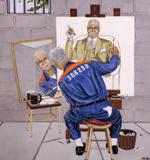





BY CHERYL DENNISON

IN 1971, the Flint Mass Transportation Authority (MTA) has celebrated 50 years!
According to MTA General Manager Edgar Benning, a formal celebration planned for 2021 was postponed due to the pandemic. The long-awaited 50th Anniversary Gala will take place on May 20 in Downtown Flint at the Riverfront Conference Center to recognize the achievements of one of the nation’s top public transportation fleets. Here are some highlights of the MTA’s first 50 years:


1971 After Flint City Coach shut down in 1970, city leaders developed a transportation plan and formed the MTA, which operated out of a bus garage at Saginaw and 12th Streets. Service to the City of Flint started with a fleet of 26 buses running hourly on 12 routes.
1976 The North Dort Highway facility was constructed. According to Benning, the 17-acre site was developed to include a headquarters for administration and operations. It is also an Amtrak center. “You could take a train or ride the bus from that terminal,” Benning says.
1985 Robert J. Foy was appointed MTA General Manager. He remained in the position until 2010 when Benning was named the new GM.
1989 The new Downtown Transportation Center was built on the former site of Uncle Bob’s Diner (Wallenberg and Harrison Streets). “This was very significant,” Benning reports. “Before it was built, people had to stand outdoors to wait for the bus and this allowed riders to wait indoors. It also provided better access to all vehicles coming into one central area.”
1990 A trackless trolley route was established in partnership with Windmill Place on 5th Avenue to shuttle residents to work and workers to a place for lunch. The MTA Board of Directors was restructured, expanding from a nine-member board to eleven members. “It brought additional representation,” Benning reports, “from small cities, township associations, the disabled community and business and education communities. It was restructured to better serve those in need.”
1996 The first MTA millage was approved. According to Benning, MTA requested that a county-wide,
expanded Your Ride service be placed on the ballot to provide additional routes. “It was approved by 78 percent,” Benning notes.
1997 The second millage was approved. “The community wanted more service. The Board of Directors asked to go for a higher-level millage to meet that demand,” Benning states.
1997 Transportation expanded to include Regional Service to Livingston, Oakland, Lapeer and Saginaw Counties. “This was the first time we were able to reach out to other counties,” Benning says, “to provide job opportunities outside of this area and bring people here for employment. We still provide this service today.”
1998 A $10 million renovation of a bus storage and maintenance facility on Dort Highway began to house 221 buses and 100 vans.
Construction also began on the 53,000 square-foot Administration & Training Facility at the N. Dort Highway property and a facility to accommodate 321 vehicles.
Inter-local agreements were established with Washtenaw, Oakland, Saginaw Livingston and Lapeer Counties to connect regional transportation services.

2003 Construction began on the Grand Blanc and Mt. Morris Your Ride Service Centers.
2004 MTA expanded primary route service time to 11:30pm; a significant change as service previously ended at 6:30pm.
2006 Construction began on the Fenton Your Ride Service Center.
2008 Construction began on the Swartz Creek Your Ride Service Center.
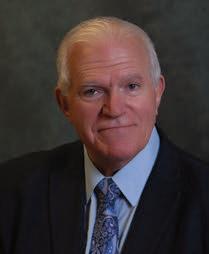
2011 Edgar Benning was appointed MTA General Manager. An employee of the MTA since 1980, Benning brought much experience to the position having held various titles, including Assistant Superintendent of Bus Operations, Superintendent of Bus Operations and Director of Customer Service. In 2001, he became Assistant GM and Chief of Staff in 2009, running human resources and other departments. “I did a little bit of everything,” he says. Prior to his time at MTA, he was Vice President of Assembly for American Sunroof Corp., overseeing six plants. →
2012 Construction began in Grand Blanc on a storage and maintenance facility for a hydrogen and compressed natural gas bus. “It was significant to bring the first hydrogen fuel cell to the community,” the General Manager reports. “Flint MTA became the biggest user of alternative fuel in the Midwest, utilizing propane, hydrogen and compressed natural gas.”

2014 A hydrogen bus was purchased from the Center for Transportation and the Environment. The hydrogen bus is unique as it creates electricity to power the electric motor. It is very sustainable, reusable, well-tested and proven that it works.
2015 Construction began on a new Compressed Natural Gas (CNG) storage building at the Grand Blanc Alternative Fuel Facility.

2016 Rides to Wellness/ Same Day Service was introduced. “This became a national model,” Benning reports. “We have become the country’s No. 1 medical transportation provider. When people need it, we provide on-demand pick-up service within 30 minutes. Demand has grown significantly. Rides
to Veterans is also growing, with free service being provided to veterans and their spouses for trips to the grocery store, pharmacy, doctor visits, etc.”
Rides to Groceries service launched, providing rides to local grocers and markets throughout Genesee County.
2017 New Compressed Natural Gas (CNG) and Fixed Route vehicles arrived utilizing funds from the second largest grant in the U.S. – $16 million to replace an aging fleet of 30-35-yearold buses. “They saw the good we were doing,” Benning states.
2018 The MTA workforce had grown to 600 employees.

2019 MTA is named 2019 Urban Community Transportation System of the Year. “We were chosen from 3,500 systems in the country,” Benning reports.
2020 Construction began on an addition to the Grand Blanc bus storage facility, which was completed in 2021.
2021 MTA’s 50th Anniversary Celebration was delayed due to the pandemic.
Anticipated annual use of diesel fuel was down to 30,000 gallons (originally 2.3 million gallons). “This was very significant!” exclaims the GM.
“We really helped clean up the community by going to alternative fuels.”
MTA, Present
The MTA fleet is now over 300 vehicles. When it started, there were fewer than 50 employees and just 12 routes running in the City of Flint only.
The Flint MTA plans to continue expanding its use of alternative fuel, especially hydrogen, says Benning. They have also joined a major group to become part of a hub for national production and are also starting to bring in more electric vehicles (cars).
MTA is developing new micro-transit and on-demand services to provide transportation when you need it. They are also developing and expediting micro-transit initiatives across the county.
MTA’s Stephanie Confer (“Stephanie K with the MTA”) provides an informative podcast with a new episode each week. You can listen to “On the Road with MTA” on Fridays on your podcast platform of choice.

“Public transportation is the fabric of the quality of life, so much more than people ever anticipated.”
The Future According to Benning, exciting things are in the works for the future of the MTA. They are working to develop a new regional service for Lapeer, Genesee and Shiawassee Counties which will provide seamless transportation to users without the need for transfers.
Currently, Benning is anticipating development of a “Bus on the Shoulder” program. This would allow buses to operate on the shoulder of the I-69 expressway during traffic backups. “MTA Buses would have the exclusive right to use the shoulder,” Benning states.
MTA is also preparing to launch a new card payment system, so that riders won’t have to carry cash. In addition, MTA hopes to attract a future workforce with educational opportunities available for those as young as eighth-grade students.
The General Manager is proud to have seen how MTA has grown and evolved over the years. “Over the past half-century, the MTA has transformed into a world-class transportation service considered by many as a model for the country,” Benning states. “Since the pandemic, our entire world has changed and we at the MTA are quickly adapting to better address the needs of the public today and into the future. We would like to thank community members for their great support over the years and we are committed to exceeding their expectations in the days ahead.” ◆





BY PETER HINTERMAN
PHOTOS PROVIDED BY PRISM PROJECT
The crime of human trafficking is at an epidemic level and the statistics are concerning. It is the fastest growing organized crime, estimated to generate $150 billion globally including an annual $32 billion in the United States. There are an estimated 4.8 million victims of sex trafficking in the U.S., 99% of whom are women and young girls. Just over one quarter are children. “The average age of a victim at the onset is between 12 and 14 years old,” says Ashley Chandler, Director of Finance for Prism Project, “and it happens in every zip code.” The outcome for victims of sex trafficking is extremely dire. “The average life expectancy of a victim is seven years,” Chandler adds. “Their deaths could be the result of physical abuse, drug overdose or suicide. Almost 45% of victims die by suicide.” The problem is immense and it is happening right now all over the country.
To help in the fight against human sex trafficking, Genesee County has been incredibly proactive with multiple organizations working to help victims, deter criminals and hold those responsible
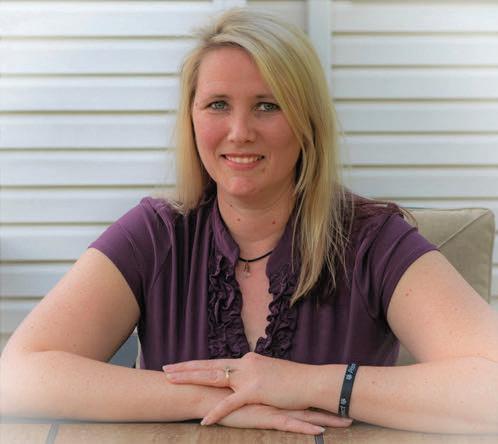
for such atrocities accountable. Programs and organizations such as G.H.O.S.T., the Genesee County Human Trafficking Task Force, Beauty for Ashes, and Voices for Children are working each and every day against the epidemic and recently, they have gained a new ally in the Prism Project. “The goal of Prism Project is to educate the community about the problem of human sex trafficking and provide wrap-around restorative services to child survivors,” explains Chandler.
The dream of Prism Project began four years ago when Founder/Executive Director Sylvia Blythe decided to do more to fight human trafficking. A sexual assault nurse examiner, Blythe saw first hand the devastating effect that human trafficking had on victims and their families. It was her hope to someday provide a place of safety and support for young victims to live and cope with their complex trauma.
She set up her 501(c)(3) nonprofit, its board of directors, and began working with the State of Michigan to license her Safehouse Program – the first of its kind in Michigan. “Nobody was sure what the rules were,” says Chandler. “Prism Project fits into different categories but we were able to get it done. In December, we received our CCI (Child Caring Institutions) license and we officially opened our safehouse in February of this year.”
When naming the faith-based organization a prism image was chosen to represent hope. “The idea is taken from a prism in the dark,” explains Chandler. “When a light shines on its shattered pieces of glass, it produces an array of immense beauty and cannot be contained. We want our child victims to know that they are beautiful, no matter what.”
What sets Prism Project apart in its mission of education and healing is the very nature of its restorative
OUR AIM IS TO BRING TOGETHER AWARENESS AND PREVENTION THROUGH EDUCATING OUR COMMUNITY AND AIDING VICTIMS TO THRIVE OUTSIDE OF THEIR OPPRESSIVE CIRCUMSTANCES."
SYLVIA BLYTHE, FOUNDER/EXECUTIVE DIRECTOR
care for victims. The Prism Project Safehouse Program “provides a safe place where child survivors of sexual exploitation and/or sex trafficking can come to heal on their time, with a loving team of professionally trained care providers.” All of the services are provided at the home including medical, educational, therapeutic and spiritual services, in addition to life skills. The home serves up to six girls ages 12-17 who may remain there for six months to two years, depending upon personal need. “We want the girls to grow up in an environment as close to a normal home as possible and to live their daily lives at their own pace,” says Chandler. “All of our care providers are licensed and trauma-informed. Care is available for the victims 24/7 and schooling is provided online.” The house sits on 100 acres and was purchased for the program by a donor. Prism Project is working to pay off the mortgage.
▸ Child not regularly attending school (missing Mondays/ Fridays)
▸ Accompanied by a controlling adult who doesn’t appear to be a parent/ guardian
▸ Having an older boyfriend
▸ Has a large amount of unexplained cash or receives expensive gifts
▸ New hair, nails, or fancy clothes
▸ Multiple cell phones, hotel room keys
▸ Demeanor change, head down, quiet
“It’s an amazing home,” states Chandler. “The land is beautiful and we are working to expand and enhance the grounds to make it even better. The children here deserve a beautiful environment.” Prism Project also works with other organizations such as Voices for Children to educate the community and provide services for victims in their care.
As mentioned, community education is a big piece of Prism Project, as they visit schools and organizations to provide factual information about human trafficking.
“It’s a subject not many people like to talk about; it makes for an awkward conversation,” explains Chandler, “but the best thing people can do to help Prism Project is to be better informed.” It begins with acknowledging that the problem exists, being aware of and identifying the signs, and knowing who to contact if you feel a trafficking situation is ongoing or has taken place. “You can call a local police department, Office of the Genesee County Sheriff, or Michigan Child Protective Services. They will open an investigation and then determine whether or not trafficking has occurred,” Chandler states.
In the future, Prism Project hopes to expand their safehouse capacity with additional housing and to begin duplicating the program for boys. “We would like to provide transitional housing for those who leave the program and also expand mentorship programming,” Chandler adds.
If you would like to help Prism Project directly, visit prismprojectmi. org and click on the “get involved” tab or the “donate” button. Gift cards to Target or Amazon are great ways to support the kids in the program with clothing and other essentials.


(BACK, L-R) GABRIEL HINOJOSA, ANTHONY MCMASTERS, TIARA POE, CHEF MARK HANDY, LILLI CANAVESIO, JULIE GARZA-SAKALIS, KYRA RICHARDSON; (FRONT, L-R) BRENDAN GERALDS, ASIJA JONES, JACQUELYN HICKS, JESSE LAWSON
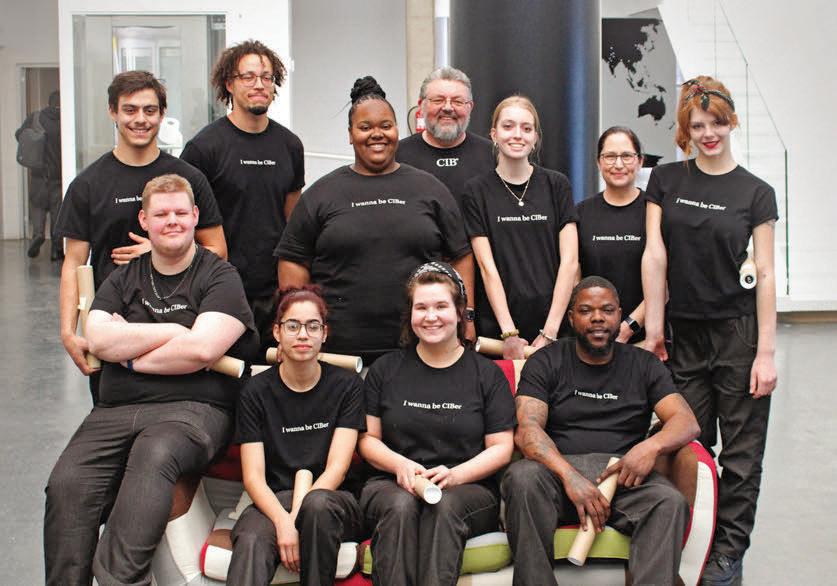
BY CHERYL DENNISON
PHOTOS
PROVIDED BY
ASIJA JONES
Yes, it was a trip of a lifetime. In March, ten lucky students of the Mott Community College Culinary Arts Institute traveled to Spain to study at the Culinary Institute of Barcelona (CIB) for ten days. "This was the first study-abroad trip for Mott Culinary students," states Chef
Mark Handy, an MCC instructor who accompanied the group on their amazing trip.
The students not only attended classes, they were also able to take in the sights, sounds and flavors of the beautiful city, an experience they say they will never forget.
MCM spoke with Chef Handy and the students about the trip and what they experienced.
According to Handy, the educational classes at CIB began at eight in the morning and included subjects such as Chocolate,
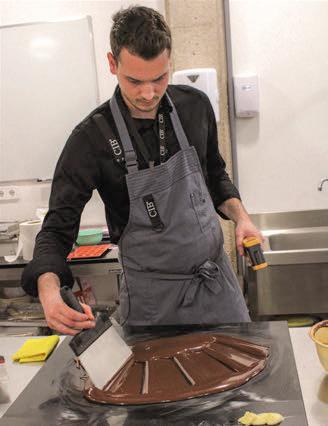


Molecular Gastronomy, Fermentation and cooking classes. They also attended a couple of Creative Thinking classes including “Change and Innovation” which was to help prepare the students for change. They also took classes in Catalan cuisine, which relies heavily on ingredients popular along the Mediterranean coast. "The classes were very different from classes in the U.S.," said one of the students. "Their approach was not traditional." In the afternoon, the students would prepare food using the skills they had learned in the morning class.
As part of the educational program, the students had the opportunity to visit a farm-to-table olive farm where they learned how olives are processed and also enjoyed
olive oil tastings. "It is a very prestigious and high-quality oil farm that has won competitions in Italy," Handy reports. "The whole tasting process was similar to a wine tasting. It was such a beautiful day to be outdoors –the temperature was in the 70s."
The students also spent a day in northeast Spain near the border of France, where they visited an anchovy factory. The group learned, among other things, how to clean anchovies. They traveled all day to get there and visited a Michelin restaurant where they were served a nine-course meal and viewed a demonstration about regional honey production.
The group also had free time for exploring Barcelona. "We took in some tourist
What the trip meant to me was being able to see another culture through other people's eyes. The trip to Spain was eye-opening and boosted my confidence for future trips."
Lillian Canavesio
This was a chance to see something you genuinely would only see once in a lifetime. It opened my mind to a new world. Interesting."
Gabriel Hinojosa

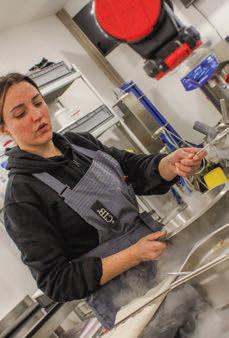

To me, this trip has opened my eyes to European travel and I one hundred percent plan on going back."
Brendan Geralds
This trip took away my fear of traveling and left me thirsty for more of what the world has to offer!"
Jesse Lawson
The experience mesmerized me, leaving me with an unquenchable thirst to explore and learn more about the world. The innovative and unconventional teaching methods at the Culinary Institute of Barcelona ignited a passion within me to seek out more diverse approaches to education in other parts of the globe."
Asija Jones
spots," Handy reports, including La Sagrada Familia – the largest Catholic Church in the world – and two Michelin two-star restaurants. They went to a Picasso museum and shopped at a flea market in a four-story building with hundreds of vendors. The group also took in the beauty of the Mediterranean Sea. "I jumped in!" exclaims Gabriel. "It was beautiful." They boarded a tram for a tour of the entire city of Barcelona and took a step back in time visiting medieval buildings in the Gothic Quarter. "It was nice to immerse ourselves in the culture," says Asija. "We did a lot of walking!" Julie exclaims, "an average of seven miles a day."
The students took note of many cultural differences – there were very few cars; transportation was by moped, trains, buses and trams. There were no Wal-Marts or big grocery stores, just small specialty shops all over the city offering fresh seafood and produce. Another difference was that each day from 2-6pm, the city shut down, the stores closed and people went home to rest. "There was a much better work/life balance there," Kyra points out. "There were so many restaurants, groceries were cheaper, food was fresher and a better climate – ten days of sunshine.”
"THEY WERE VERY IMPRESSED WITH OUR STUDENTS! I BELIEVE AN EXCHANGE PROGRAM WILL COME OUT OF THIS.”
CHEF MARK HANDY
The students and Handy stayed in an Airbnb rental. "We lived together for ten days with only two bathrooms," one of the students shared. "We knew each other from school but have now bonded for life. We stepped up and helped each other." Chef Handy adds, "We built a family really quickly."



As a chef, the trip for Handy was “like being a kid in a candy store – there were bakeries and coffee shops everywhere! Lunch was included in the education program so they sent us to a different restaurant every day. The experience was great. We were seated in a private room at the restaurants and the chef would come and talk to us."
For both Handy and the students, their last night in Barcelona was one to remember and very special. Greg Campbell, the pastry chef at Mott Culinary Institute, had donated $500 to do something special for the students. Handy used that money for their last dinner at Restaurante Port Vella, a star-rated Michelin restaurant located in the harbor. It was a chilly night but the sea was warm so they sat outside overlooking the water. The scrumptious meal included a variety of seafood – lobster, calamari, oysters and salmon. A “mystery meat" was served (pork shoulder) with goat cheese salad and carrot cake for dessert. "It was a great experience!" Handy exclaims.
According to Handy, the study-abroad trip was a work-in-progress for a couple of years. "In 2019, a group was going to go to
Florence, Italy," he shares. "The pandemic hit and we had to cancel. It was very exciting to finally get to Barcelona."
According to Handy, the relationship and education level of the students and administrators at the Culinary Institute of Barcelona was outstanding. "They were very impressed with our students," he shares. "I believe an exchange program will come out of this and we will have a future relationship. I was asked if I would do the trip again. Yes, I will!"

THE MCC STUDENTS ENJOYED SOME EXCEPTIONAL DISHES WHILE IN SPAIN, INCLUDING CARAMELIZED DUCK LIVER TERRINE AND PRAWN CROQUETTES.
I am grateful for this experience. I enjoyed the food in Spain and taking classes at the CIB. The instructors there were great! We learned about creativity using ‘mind maps’ to help make different food dishes."
Julie Garza-Sakalis
"I have always been an avid traveler. Studying abroad in Spain was an incredible enhancement to both my education and career. The opportunity to absorb so much information as well as make anthropological observations outside my home country changed my life and will undoubtedly give me a step up in the job market."
Kyra Richardson



Formany people, the home of their dreams has a lake view … there’s nothing like waking up early to the glasslike water with swans floating gracefully, maybe a few kayakers and a fisherman or two enjoying a peaceful morning. Wait a few hours and the lake comes alive with the sounds of lake enthusiasts having water fun of every kind! The season for summer fun may be short-lived, but most lake homeowners would not want to live anywhere else.
With access to 79 lakes ranging in size from the 24-acre Atlas Mill Pond to the 1,975-acre Holloway Reservoir Regional Park, Genesee County residents have endless opportunities for all manner of summer fun! Leisure boating, water sports, fishing or just soaking up the sun … There is something for nature lovers and adventure seekers of every kind.
The world revolves around water and it is our natural instinct to want to be near it. Lake living is a world of its own and once you get the chance to enjoy it, there is nothing better. This section has lots of info about local fishing, and expert tips for finding the right boat for your needs and buying the lake home you’ve been dreaming about.
Get ready … The lakes are calling! ◆

BY PETER HINTERMAN
THERE ARE APPROXIMATELY 79 LAKES IN GENESEE
COUNTY ranging in size from the tiny Atlas Mill Pond to sprawling Lake Fenton and Holloway Reservoir. The majority are private or have restricted access, unavailable to traveling fisherman or
LOCATION: 10 miles NE of Flint in Thetford Township off Genesee Rd.
DEPTH: 47 ft. (Max.)
ACCESS: One public boat launch (Buell Lake County Park), two floating fishing piers, and shoreline fishing.

GAME: Buell Lake provides a variety of game and pan fish breeds with bluegill and largemouth bass making up nearly 95% of all stock. Other fish found in Buell Lake include black crappie,
landlocked anglers; however, the public lakes provide a good variety and bounty of fish to make every trip worthwhile. Here is a rundown of public lakes in (and around) Genesee County and what they offer.
bullhead, carp, pumpkinseed sunfish, yellow perch, walleye and northern pike.
LOCATION: 7 miles NE of Flint in Richfield Township off Stanley Rd.
DEPTH: 14 ft. (Max.)
ACCESS: One public boat launch (Holloway Reservoir Regional Park), one floating fishing pier, and shoreline fishing.
GAME: Holloway Reservoir was created with the construction of the Holloway Dam in 1955 as a source of freshwater
GAME: The Kearsley Reservoir was created in 1929 for Flint ice supply. The lake is now used for recreation and holds a small variety of fish including bluegill, pumpkinseed sunfish, black crappie, rock bass, yellow perch, largemouth bass and northern pike. Bluegill make up nearly 50% of all fish in Kearsley Reservoir.
LOCATION: Fenton Township just south of N. Long Lake Rd.
DEPTH: 90 ft. (Max.)
ACCESS: One public boat launch (off of Grove Park Rd.)
for the city of Flint. Today it is used almost solely for recreation. Catfish, walleye and black crappie comprise 57% of the fish varieties in the reservoir. Fishermen will also find a good number of carp, bluegill, small and largemouth bass, sunfish, yellow perch and northern pike.
LOCATION: Approx. One mile NE of Flint off Western Rd.
DEPTH: 15 ft. (Max.)
ACCESS: One floating fishing pier (Branch-Carr Park) and shoreline fishing.
GAME: The largest lake in Genesee County, Lake Fenton is a hotspot for summer fun and activity. It is recommended to be on the waters early before recreation enthusiasts hit the water. Anglers can expect to find black crappie, sunfish, bluegill, yellow perch, suckers, small and largemouth bass, walleye and northern pike in its waters.

LOCATION: 20 minutes south of Flint in Fenton Township
DEPTH: 77 ft. (Max.)
ACCESS: One public boat launch (off Eastview Dr.)
GAME: Lake Ponemah connects two other lakes, Aanikegamaa Lake and Tupper Lake. The Shiawassee River runs through the lake bringing a wide array of game with it. Anglers on Lake Ponemah will catch their fair share of black crappie, multiple varieties of sunfish, yellow perch, small and largemouth bass, suckers, walleye and northern pike.
(and Bennett Lake)
west of Genesee Rd.), one small craft boat launch (off Stanley Rd.), four floating fishing piers, and shoreline fishing.
LOOKING FOR A NEW EXPERIENCE? HERE ARE FOUR FISH-HEAVY LAKES LOCATED OUTSIDE THE CONFINES OF GENESEE COUNTY.

LOCATION: Ortonville Recreation Area in Lapeer County just west of Davison Lake off Hadley Rd.
DEPTH: 70 ft. (Max.)
LOCATION: Elba Township in Lapeer County off Lake Nepessing Rd.
DEPTH: 25 ft. (Max.)
LOCATION: Southern end of Argentine Township
DEPTH: 78 ft. (Max.)
ACCESS: One public boat launch (off of Seymour Rd.)

GAME: Lobdell connects to Bennett Lake in Livingston County and fishermen can enjoy both from the Lobdell Lake access point. The lakes hold a variety of panfish and predators such as sunfish, yellow perch, black crappie, grass pickerel, largemouth bass and northern pike.
LOCATION: One mile NE of Flint off Genesee Rd.
DEPTH: 18 ft. (Max.)
ACCESS: One public boat launch (James Bassett Dr.,
GAME: Mott Lake was created in 1972 for public recreation with the construction of the Mott Dam. The lake has been stocked with a variety of fish throughout the years, last stocked in the late 90s. Catfish, bluegill and walleye makeup 87% of all fish in Mott Lake at last DNR count. Anglers can also find smallmouth bass, largemouth bass, yellow perch, rock bass, black crappie, sunfish, bullhead and northern pike.
LOCATION: NE corner of Genesee County in Forest Township
DEPTH: 117 ft. (Max.)
ACCESS: One public boat launch (off of Genesee Ave.)
GAME: Potentially the deepest little lake in Genesee County, Otter Lake is known to be a fun fishing spot for all ages. Bluegill make up 78% of the fish but skilled anglers can easily find black crappie, largemouth bass, bullhead, northern pike and warmouth.
ACCESS: One public boat launch and shoreline fishing (Big Fish Lake Park)
GAME: Nearly 75% of the game is bluegill and pumpkinseed sunfish. Black crappie, bullhead, grass pickerel, largemouth bass and northern pike round out the rest. Whether or not the lake lives up to its name remains to be seen. Why not give it a go and find out for yourself?
LOCATION: Southern end of Lapeer County just east of Big Fish Lake off W. Davison Lake Rd.
DEPTH: 67 ft. (Max.)
ACCESS: One public boat launch (Big Fish Lake Rd.)
GAME: The Fish variety mirrors that of its neighbor Big Fish Lake in a much more private setting. Fishermen will hook a bevy of bluegill, sunfish, black crappie, rock bass, yellow perch, largemouth bass and northern pike.
ACCESS: One public boat launch (off of Hunt Rd.)
GAME: A local favorite, home to the bowfin, one of the rarest fishes in Michigan. While hunting the rare fish, anglers will most likely catch bluegill and sunfish which make up almost 90% of the fish in Lake Nepessing. Others include rock bass, yellow perch, bullhead, black crappie, warmouth, largemouth bass and northern pike.
LOCATION: 3 miles NE of Millington in the Murphy Lake State Game Area in Tuscola County
DEPTH: 41 ft. (Max.)
ACCESS: One public boat launch (off Murphy Lake Rd.) and shoreline fishing
GAME: Anglers will find black crappie, bluegill, sunfish, catfish, smallmouth bass, walleye and northern pike. Black crappie and bluegill make up nearly 82% of all fish in Murphy Lake. ◆


BY PETER HINTERMAN
many of us, summertime brings back memories of visiting a family member’s house on the lake and all of the good times we had. Doing cannonballs off the dock, being pulled behind a boat on a tube and flying off to roaring laughter from friends, being able to “stand up” on water skis for the first time, early morning fishing … the list goes on. Here are five reasons to search for that lakeside property you’ve always wanted.

1
Banish Boredom. Go jump in a lake! On good days and bad, warm or cold, the lake is there for you and the possibilities for fun are endless. Swimming and fishing are the most obvious and a little cliched. You can do more! How about water sports like jet skiing, water skiing or tubing. Break out the kayak, get some exercise, and identify water creatures you see along the way. Conduct a few science experiments in nature. If your lake freezes over in the winter, set up a hockey rink or go ice fishing. If all else fails, just relax and listen to the sounds of nature while you read a good book.
2
Photo Opportunities. If you live on a lake, you will find yourself embedded in a million new hobbies and photography will be one. From animals to sunsets, to family and friends, you will want to capture all the fun and beauty you see every morning and every night. Make room in your budget for some high-end technology – you’re going to need it.
3
Lakes are for Entertaining. You have memories of visiting family on the lake when you were a kid and now you can create your own, instead. Invite the extended family for a weekend to show those nephews, nieces, cousins and grandparents a good time. Have friends over for a barbecue and a swim or boat
ride. Break out the guitar and sit around the bonfire while the moonlight dances on the water.
4
Improve your Health. Lakes provide more than fun – they encourage you to seek fresh air and relaxation. How can you be tense when you are sitting on your deck on a clear summer morning, drinking your coffee and watching the waves? The air smells fresh and clean as you take it deeply into your body. When you finish a tough day of work in the yard, take a running leap into the water and swim out the kinks. Your mental health will likely improve just as much as your physical health.
5
A Sportsman’s Dream. If you are into wildlife, a lake is your happy place. Varieties of fish and other aquatic animals abound. For birders, the lake is your best chance to observe unique species. Beavers, deer, snakes, turtles, eagles ... The list is nearly endless. Make a list and see how many you can find – a great educational activity with the kids and grandkids.
The lakes are calling … ◆
BY MARY RISING, ACTION WATER SPORTS OF FENTON
WHEN SHOPPING FOR A BOAT – a significant purchase – there are many things to consider. What is your budget? Where do you plan to boat? Will you be towing water sports, fishing or just cruising around the lake? How many passengers might you have? Is there a size restriction on the lake? Where do you plan to store your boat in the winter? All these factors determine which watercraft is right for you.
Any salesperson whose goal is to steer you toward the “perfect purchase” as opposed to just “making a sale” will take the time to get to know you, your needs, and honestly educate you. Ultimately, the answer might be that another dealership would have the right boat for you.
Other considerations: Have you been to the dealership? Were you greeted and made to feel important? Was the facility clean, well-organized and appearing to have a well-functioning service department? What is their reputation? Do they offer dockside service, pick-up and delivery? Storage options? What kind of warranty is included? Did they offer a test drive? (You probably won’t buy a car without a test drive.)
At Action Water Sports of Fenton, our most popular boats are MasterCraft wakeboard and surf boats.The newest and greatest offering is the

award-winning SurfStar System – an integrated system with asymmetric tabs, a custom hull design and an intuitive operating display. They can operate in surf mode at lower rpm than our competitors’ models. We also offer more adjustability of the wave – from long and mellow to taller and steeper, in a range from 1-7 that is quickly changed with a touch of the intuitive display screen. Once you find the perfect wave, a profile can store the info to be easily retrieved for your next turn behind the boat.
If the answer is to educate you and direct you elsewhere, that is what we will do. Of course, our goal is to suggest the perfect boat that will bring you the ultimate satisfaction and maximum fun … that’s what it’s all about, right?


BY JENNIFER LASCO, REALTOR/BROKER, MBA, RENE, CBR
It is hard to beat a Michigan summer … and even harder to beat if you are one of the lucky people who live on one of the beautiful lakes in, near or around our community. In April, with the almost 80-degree days sprinkled through the month, many of us have already seen the light at the end of the tunnel of winter to the long, sunny days headed our way. If you are in the market for a lake home to enjoy the reprieve of the cool water on hot summer days, now is the time to key into the market for a lake property and make a move. Because of their limited availability, lake properties are almost always a solid investment – when they are gone, they are gone. Before diving into the market to purchase a lake home, there are many unique considerations. Simply choosing where to buy and if the timing is right are only minimal pieces of the puzzle to build your ideal lake life. In my experience, the best place to start when thinking about purchasing waterfront property is to consider what your expectations and needs are lifestyle-wise from
lake life. Goals may include a pleasant view, evening pontoon rides, watersports, paddle-boarding or kayaking, kids playing on a sandy beachfront, etc. With each of these activities, one lake may be more suitable than another. As all natural creations are, each lake is different and each offers many unique qualities and characteristics that the others may not. With the pricing varying a great deal between lakes, there is no need to pay the lot cost and taxes for an all-sports lake when a quiet spot to paddleboard a few evenings a week is what you truly desire.
If you’re not interested in speed-boat style water sports (surfing, wakeboarding, water-skiing), a motorized pontoon or jet-skiing and would prefer wooded seclusion, lots of wildlife, kayaking, canoeing and fishing, a small private lake would be a more ideal choice than an all-sports lake. Not only will a property on the smaller lakes typically be a bit less expensive and offer lower taxes, but you will also find a more calm and peaceful atmosphere than on a public lake. The smaller,

When
you consider a lake home purchase, there are many questions to ask:
• Is the lake public or private?
• Is the shoreline sandy, rocky, muddy or mucky?
• Is the lake all-sport, no-motor, no-wake?
• How are the weeds in the lake?


• Are there any easements on or around the property allowing surrounding areas or the public access to it?
• Does the DNR control and/or patrol the lake and the Riparian Rights of the property owners?
• Is there a sandbar in proximity to the property? Does it get very busy and when? Is there a party there every day in the summer with very loud music?
• If there is a dock or hoist at the property and does it belong to the owner? Will he be leaving it? Will the dock need to be removed seasonally or is it fixed?
• Whether public or private, are boat slips sold anywhere on the lake? →


Because of their limited availability, lake properties are almost always a solid investment – when they are gone, they are gone.
private lakes offer limited access to residents only, and vary in their usage. Some of these lakes are all-sports, while others allow only small electric motors, or small pontoons with electric motors, but nothing larger. These are “no wake” lakes. However, some don’t allow any type of motorized boat at all (“no motor” lakes).

When buying lakefront property, the location on the lake is another very important factor. It impacts the value of your home almost, if not as much, as the condition of the home itself. Variations could include being located near the public boat launch; on a channel vs. the open water; across the street from the water with access and dock across the street, etc. Each of these lake placements come at a different cost, and each variation should be closely considered when making an offer on a home. Comparable properties used to determine your offer price should be in line with each of these criteria. Just like you wouldn’t pop into your local Ford dealer to ask about surf-boats, you should never look for lake properties with a Realtor who doesn’t live on a lake. The intricacies of lake life can be complicated. With such an expensive investment at stake, you should take the time to seek out an expert to handle your concerns and point out others you may not have considered. Many of the questions about lake homes that we help homebuyers with every day are answered using the knowledge and experience we have gained from living and experiencing lake life for decades.
Happy House Hunting! ◆




BY PETER HINTERMAN
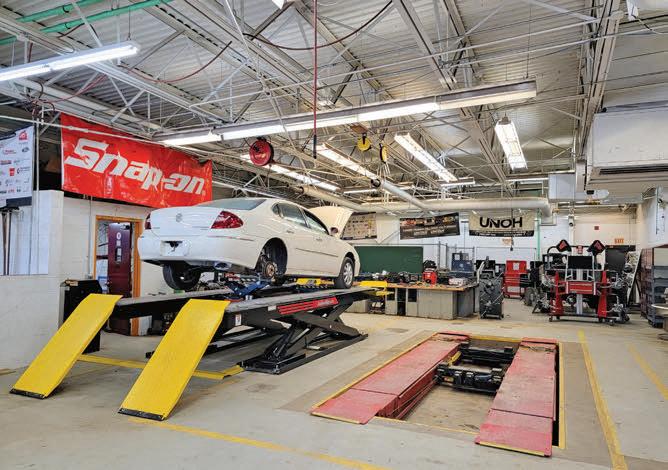
In February of this year, the Davison Auto Tech program was named one of the Top 4 in the nation as a finalist in the O’Reilly Auto Parts “Tomorrow’s Technician School of the Year” competition earning the program a $500 dollar gift card. “Our program went up against colleges, vocational schools and other high school programs across the country,” said Davison Auto Tech Teacher Andrew Michalik. “It’s a big honor and we are very proud of our program and our students.”
Davison Auto Tech is a two-year program open to Davison High School juniors and seniors with an interest in automotive technology. The program is so popular with students, however, that Michalik is pushing to open it up to sophomores. “We have a long waiting list,” he says. “I can’t get every kid in here who is interested. We might have
to hire a part-time teacher!” he laughs. The program’s popularity is easy to understand, considering that Davison Auto Tech is often a direct line to future employment. Students are encouraged to partake in Davison’s co-op program to gain valuable on-the-job experience at local dealerships and auto shops, and top students in the program are eligible for scholarships to one of the many partnership schools such as Ohio Technical College, University of Northwestern Ohio, Universal Technical Institute, Ferris State and others. Ryan, a Davison High Senior in year two of the program, will take advantage of the opportunity and attend Ohio Technical College for Electrical work next fall. “Before Davison Auto Tech, I had no idea what I wanted to do in the future,” he says. “During my first year in the program, I realized that this was something I loved
to do. I decided to study electrical work more in-depth for a career.” Michalik is constantly fielding calls from local dealerships inquiring about whether or not he has any students looking for work. Recently, he was contacted by a company looking for students interested in working on diesel pumps – two second-year students have expressed interest.


Auto Tech students study a variety of techniques and systems related to working on and repairing vehicles such as electrical, welding, engine replacement, brakes, rotors, struts, computers and more. “In my program, it’s not unusual for a senior to have built a few transmissions before they graduate,” says Michalik. “A lot of the kids show up early on Wednesdays during the week to work on specific skills they want to improve like welding, for example.” Vehicles for study are provided by Davison faculty, donors, program alumni and the students themselves. It’s not uncommon for them
IT’S CRAZY TO THINK THAT IN TWO YEARS, WE WILL HAVE GIVEN AWAY $800,000 IN SCHOLARSHIPS.” INSTRUCTOR, ANDREW MICHALIK
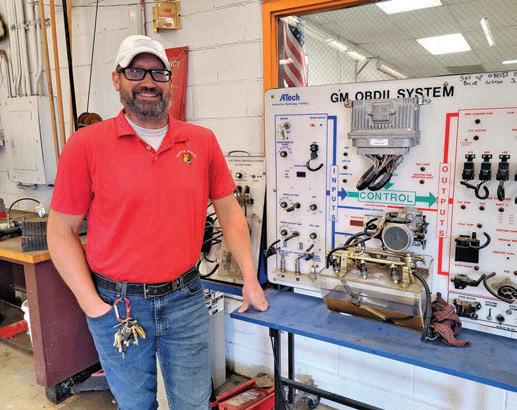
to bring in their own transportation for fixes or upgrades. The program is able to accommodate a variety of vehicles at any one time and work on numerous break-downs as it features four hoists, two alignment racks, welders, a plasma cutter, computers and everything else needed for a true auto shop. “I’m very

thankful that Davison supports the program 100%,” says Michalik. “They get us what we need.”
As a bonus, the program has its own drag racing car, a couple of off-road vehicles that students are able to drive at The Mounds ORV Park, and Michalik’s own monster truck, the “Insane Instructor.” Michalik asks, “How many kids can put the fact that they worked on a monster truck on their resume before graduating high school?”
The newest thing the students are working on are hybrid and electrical systems, although components are very hard to come by. “We are desperately in need of hybrid system components,” says Michalik. “I recently purchased a 2011 fully-electric Nissan Leaf with my own money just so the kids could understand how it works and drive it. It’s so old, the battery only lasts for about 60 miles. It’s enough to get to work and back but it did die in my driveway once. That was close – I had to push it into my garage.”
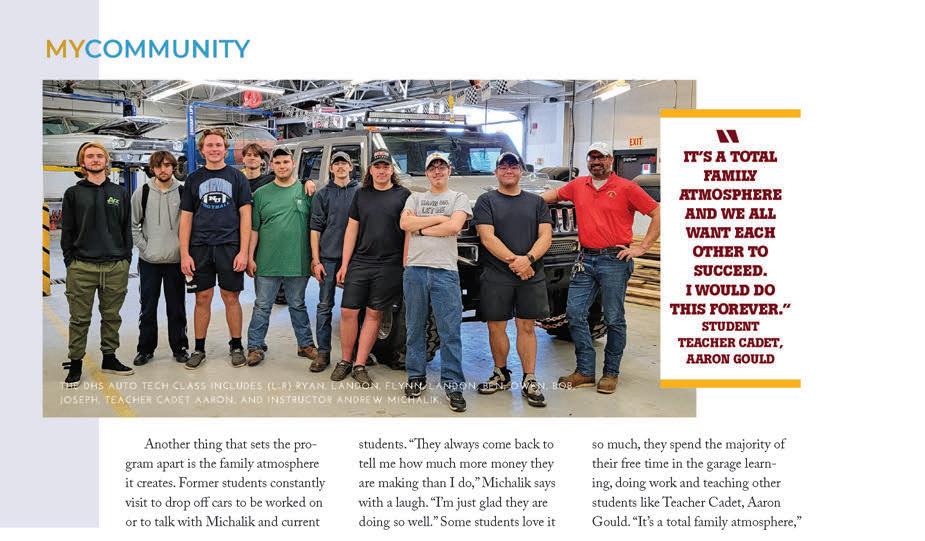




BY SHANNON WHITE
While April Showers bring May flowers, it can sometimes still be rainy in May. We start this month’s style trend with a new jacket!
In the Midwest, May brings a transitional season with chilly temps in the mornings and evenings and the glimmer of hope that Memorial Day will kick off the summer season. In southern states, May is often rainy and an afternoon shower can make you wish you had an umbrella or raincoat in the car with you at all times. Spring jackets can be bright and colorful to cheer up a dreary day. Bold prints can spice up demure solids underneath or top great denim and become staple pieces on their own. Chunky belts cinch your waist, quilted or

lightweight down puffer jackets and vests provide a layer that is “just enough” and athleisure-style sporty jackets can be thrown over leggings and tanks and tees for the
perfect Farmers’ Market Saturday stroll or your kids’ sporting events every day of the week (and twice on the weekends!) Denim jackets in white, blue and camo are the quintessentially perfect layering piece this spring and will carry you through summer evenings, dinners and parties as well.
For the last couple of months, we have highlighted long hemlines that are trending through fall. While maxi and midi-skirts and dresses are the rage, additional details that are fabulous and slimming



include smocking (defines the torso), accented by ruffled sleeves (creates the illusion of slim shoulders) and tiered hemlines below the bodice. Tiers accentuated with a little ruffle or unique stitch detail provide dramatic lengthening to the legs while “dressing up” a great maxi with visual interest so it's not a long, boring frock. Even shirts and jumpsuits are borrowing these gorgeous sleeve details and stitching that create a slimming bodice.
Lastly, May brings so many celebratory events! Quick weekend vacations, graduations, spring parties, weddings and more – these functions call for great gifts. Even the smallest gift shows a gesture of appreciation to a hostess or the celebrant and doesn’t need to be lavish. Fun napkins or wine markers paired with a great bottle of wine or bubbly, a beautiful cutting board paired

with a local cheese from the Farmers’ Market or The Cheese Lady, a hilarious and witty dishtowel paired with a small cookbook or fun servingware are all great gift ideas. Don’t forget end-of-year teacher appreciation gifts, as well – because, well, we SO appreciate teachers giving of their time, talent, patience and sanity to teach our children all year long. Yeti®-style custom insulated tumblers with cute sayings or silicone wine glasses that can easily be thrown into a beach bag make great gifts that are surely more fun than an apple or a plant!


SHIFT in Flint has all of this and more – don’t forget to shop local and support small businesses this May!



Shannon White is an architect, designer and fashionista –a small but mighty cheerleader of all things Flint! Holding both Bachelor of Science and Master of Architecture degrees from the University of Michigan, she is the founder of the FUNchitecture design firm and co-founder of she-powered Downtown Flint retail business, SHIFT.



BY ERIN CAUDELL
Oneof the joys of springtime in Michigan is the availability of locally-grown asparagus. The short-lived season is when asparagus lovers “overdose” on the gorgeous, green spears – baked, grilled and sautéed. Adding lemon or a balsamic dressing really makes the green, fresh flavor pop.
This dish can be enjoyed cold or warm and highlights what’s best about asparagus. The simplicity of the recipe allows for many variations; try it with different herbs like oregano and parsley.

• 1 cup dr y orzo pasta
• 1 lb fresh asparagus cut into 1-inch pieces
• ¾ cup fresh grated Parmesan cheese

• 1/3 cup fresh basil, finely chopped
• ¼ cup fresh dill, chopped
• 3 Tablespoons olive oil
• 1 medium lemon, zested & juiced
• 1 c love garlic, grated
• 1/3 teaspoon crushed red pepper flakes
• 2 Tablespoons butter
Boil water and add orzo according to instructions. In the last two minutes of cooking the pasta, add the asparagus. Drain all and put back into the pot with butter. Stir until butter melts. In a medium bowl add oil, lemon juice and zest, Parmesan, herbs, garlic and pepper flakes. Whisk together and stir into pasta. ◆

Erin Caudell is co-owner of The Local Grocer, a horticulturalist, herbalist and farmer.

















BY CHERYL DENNISON

I don’t know what it is about food your mother makes for you, especially when it’s something anyone can make – pancakes, meat loaf, tuna salad – but it carries a certain taste of memory.” – Mitch Albom
We all know it's true ... Moms are the best cooks! Just ask multiaward-winning local news anchor and journalist, David Custer. He recently self-published a cookbook entitled Moms Make It Best. And in his eyes, his own mom, Judy Custer, makes the best food.
How did he come up with the idea for a cookbook when he is not a chef or even a good cook? He would often tell others that his mom made the best food. "Friends would share with me how their
mom had the best recipes – it was a recurring theme," Custer says. "My favorite experiences involve gathering in the kitchen with loved ones. Great-tasting food brings people together."
Last summer, Custer started the process of collecting recipes from his own family and other moms. He thought about all of the moms he knew who had recipes that have often been handed down generation to generation. "There are a lot of moms in my life who I have met along the way,” he remembers,
“and I just started reaching out to them." Each recipe includes the name of the person who contributed it to the book and a little about its history.
Custer finished compiling the cookbook in November 2022. He designed the cover art and did some of the food photography himself. Some of the moms who submitted recipes also provided photos of their featured dish. "My favorite part of this book is the stories behind their recipes," says Custer, "and why it is so important to them.”
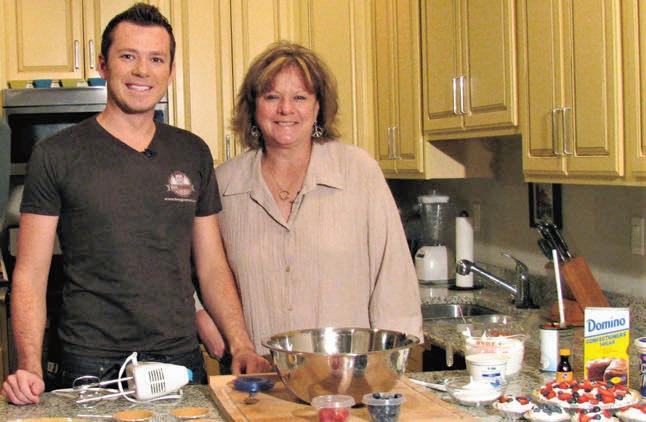
During the process, Custer also noticed that there are memories connected to family recipes, as well. "We all have fond memories of being in the kitchen with our family," he says. “The recipes also speak of heritage and where a person came from.” An example of that is Daphne Deloren's grandmother's recipe for Turkish Burgers. "This is a recipe from my Turkish roots," Deloren says in the book. "I felt so honored when my family let me make it during our summers in Turkey. I now make it for my husband and two boys and they love it!"
Judy Custer shared cherished family recipes that have been passed down through generations. The book includes recipes from all of Custer's grandmas,
MY FAVORITE EXPERIENCES INVOLVE GATHERING IN THE KITCHEN WITH LOVED ONES. GREATTASTING FOOD BRINGS PEOPLE TOGETHER."
- David Custer
great-grandmas and great-great grandma. "My great-grandma, a little Romanian lady, always had great recipes and she measured the ingredients with her hand. To replicate the recipe, my mom would make her stop so she could measure it," he says with a smile. One of his favorite recipes is his great-grandma Martha McCoy's Chicken & Dumpling Soup. "My mom makes it for me on my birthday."
There are a lot of busy moms in the world and Custer included many recipes in the cookbook that are easy to replicate. "A lot of it is about convenience and being 'quick and easy' for busy moms," he adds. Moms Make It Best has recipes for soups and salads, main dishes, sides, appetizers and much more,
and according to Custer – a lot of sweets and desserts. Although he claims he isn't a good cook, he says he loves to eat. "Working the second shift, I don't have a lot of time to

JUDY CUSTER MAKES HER GRANDMOTHER’S CHICKEN & DUMPLING SOUP FOR DAVID ON HIS BIRTHDAYS.

“I never got the chance to meet this woman, as she is my great-great grandma. She came to the United States from Romania in the early 1900s. She was the mom of my great-grandma Martha who was very inspirational in creating this book. My "Granny" submitted this recipe and said it was her Grandma Eva's recipe.”

cook, but I prep meals for the week and enjoy eating healthy."The book does include one of Custer’s own recipes – a simple Hash Brown Casserole. "I always make it for Thanksgiving dinner."
When he created his cookbook, his goal was to bring people together through the power of food. "That's what is most important," he says.
Judy Custer has enjoyed being a part of her son's creative efforts. "I love to cook!" she exclaims,
Kifli
Dough
▸ 1 1/2 cups butter
▸ 3 cups flour
▸ 1/2 teaspoon salt
▸ 4 eggs (yolk only, whites will be used later)
▸ 1 cup sour cream
▸ 1 pkg. dry yeast
▸ 1 /2 cup lukewarm milk
Filling
▸ 1 pound walnuts
▸ 1 cup sugar
▸ 4 eggs (whites only)
Mix flour, butter and salt until pie crust dough begins to form. Add sour cream. Dissolve yeast in warm milk. Add to dough and let stand overnight.
Preheat oven to 325 degrees. Blend nuts, sugar and egg whites in blender for filling. Take 1 Tablespoon of dough and roll onto floured board into a 3x3-inch square. Place one full teaspoon of filling in center and fold like a crescent roll. Roll in powdered sugar and bake for 20 minutes on cookie sheet. Sprinkle with powdered sugar while hot.
adding that it runs in the family. “My grandma was an amazing cook and I got a lot of recipes from her.” And she says her son is quite a good cook, too. "He just won't admit it," she adds. What Judy loves best about the book is that it is all about family, friends and favorite recipes. "I love that part of it."
What’s one of her son's favorite dishes she makes? "He loves my meatloaf."
It really is true. Moms DO make it best!


BY PETER HINTERMAN
When Eric and Jen Janetsky moved to Flushing from Saginaw in 2019, they brought more than belongings. Packed with the dishes, clothes, furniture and more was a life filled with music and companionship. Each box opened revealed a song and a story, a melody and a friend. It was almost mandatory to share it all with their new home community. “We love the community here and that’s one of the main reasons for creating Farmhouse Folk,” says Eric Janetsky. “We want people to come together, mix and mingle, and listen to amazing music.”
The Janetskys are accomplished musicians in their own rights, both solo and with their band The Lucky Nows. Throughout their travels in Michigan’s lush folk music scene, they have made quite a few contacts in the industry and gained many talented friends. In fact, Farmhouse Folk began years ago in Saginaw with the innocent request of one such friend. “Our friend Rebecca Loebe wanted to do a house show,” remembers Janetsky. “Consequently, she was the first of our house shows in Saginaw and also the first Farmhouse Folk show here in Flushing.” For the last four years, Farmhouse Folk has welcomed musicians from all over Michigan and the country to their little venue in Flushing including Edie Carey, Grace Pettis, Peter Mulvey, Annie & Rod Capps, Sarah Peacock, Drew Nelson, and Jill Jack, to name a few. Each musician brings something different to the table. “We have a good mix,” says Janetsky, “all folk musicians, but each is different. Some are more bluesy, some jazzy, and traditional. In 2020, we really had a great lineup planned but the pandemic ended that. It’s been a slow recovery for us and for all musicians, really.” Farmhouse Folk is quickly getting up to speed again.
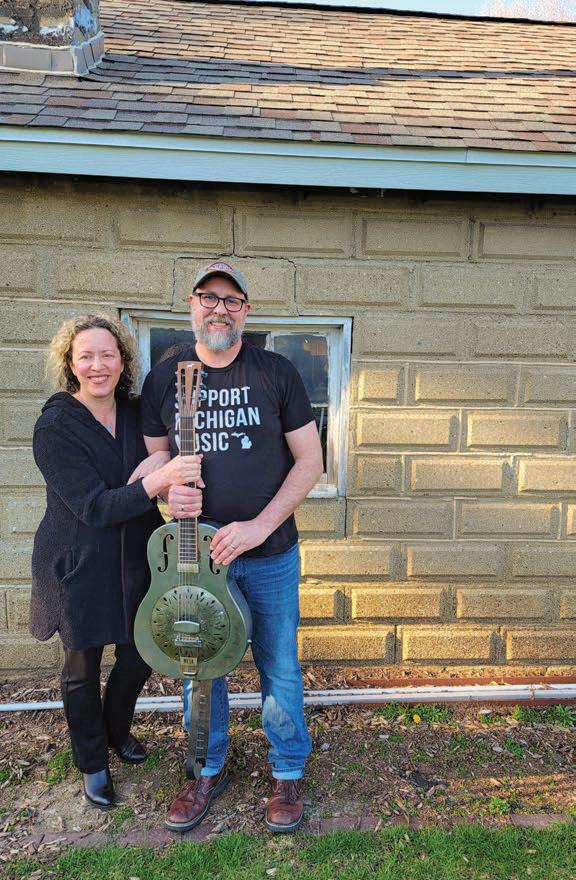
WE LOVE THE COMMUNITY HERE. WE WANT PEOPLE TO COME TOGETHER, MIX AND MINGLE, AND LISTEN TO AMAZING MUSIC.”

Arriving at the Farmhouse Folk venue, you are welcomed by a well-maintained farmhouse the Janetskys call home. Behind the house in a country barn is where the music happens. “It used to be a literal pig stye,” says Janetsky with a laugh. “We worked very hard to renovate it and we invested time and money to create a great venue for performers and their audiences.” At the head of the barn is the stage where the musician(s) play, immersed in colored lights. Seating for 35 people is no more than five feet away in a double row of chairs. Adorning the walls are musical instruments and paraphernalia – a closer look reveals autographs of artists who have previously played there.
“The acoustics are incredible,” adds Janetsky. One of the best things about seeing a show at Farmhouse Folk is the intimacy and audience companionship. It may be Genesee County’s
most intimate music venue. “I can tell you that the artists really do prefer a smaller setting,” explains Janetsky. “They play the bigger shows because they pay more, but artists really want to connect with their audience.” At Farmhouse Folk, the audience gets a personal experience with the music. The goal is to have a great night, meet the artist, listen to the stories and enjoy great music. “We are not a bar,” Janetsky says with a chuckle. “The audience isn’t here to yell out requests or anything like that. We like to maintain a good vibe and enjoy the songwriting and storytelling.” That being said, the Farmhouse Folk experience is more than a show. Music lovers are welcome to arrive an hour before the show begins when they can meet fellow audience members, partake of a delicious taco bar and relax. Non-alcoholic beverages are provided; those wishing to bring an adult beverage may do so.

MICHIGAN IS SPECIAL WHEN IT COMES TO MUSICAL TALENT. PEOPLE MOVE TO NASHVILLE FROM ANOTHER PLACE; MICHIGAN MUSICIANS ARE MADE HERE.”
ERIC JANETSKY


BY PETER HINTERMAN

Earlier this spring, the Prison Creative Arts Project (PCAP) concluded its 27th Annual Exhibition of Artists in Michigan Prisons at the James and Anne Duderstadt Center Gallery in Ann Arbor. The PCAP brings the art and talent of those impacted by the justice system to local communities for collaboration, mutual learning and growth. “We see art as a common language for people to connect with others across distances and differences,” says PCAP Director Nora Krinitsky. “PCAP connects justice-impacted persons to others through multiple programs such as the art exhibition, creative art workshops in prisons, our yearly literary
beautiful community of talented artists that exists in Michigan’s correctional facilities.” If you missed the exhibition in early spring, don’t worry. PCAP’s traveling exhibit entitled “Shared Humanity” will be coming to Flint in August. “We will open the exhibition on August 11 during the Flint Art Walk at the Greater Flint Arts Council, and I’m so excited!” Unrath exclaims.
The PCAP traces its roots back to 1990 and University of Michigan English Language and Literature Professor, William “Buzz” Alexander. “Buzz first visited the Florence Crane

journal and more.” “We’ve represented over 360 artists from all correctional facilities in Michigan,” says PCAP Community Engagement Specialist and Curator, Sarah Unrath. “There is a
Women’s Facility in Coldwater (MI) to conduct a theatre workshop with the inmates there,” Unrath explains. “He brought university students with him. It was such a wonderful experience that


it continued year after year.” The Prison Creative Arts Project was soon established and expanded to include other forms of expression such as writing and music. At Florence Crane, the theatre troupe founded by Alexander in 1990, The Sisters Within, continues today even after closure of the Florence Crane facility.
Today’s PCAP visual arts exhibition was started in 1996 by Janie Paul, Buzz Alexander’s wife and a local Ann Arbor artist. “She accompanied Buzz to a theatre workshop he was conducting and saw the visual art they were creating. She was compelled to bring it to the public,” adds Unrath. The first exhibition opened with a collection of 50 pieces and has grown to include 645 to date. “What we’ve found is that almost 90% of inmates pick up their first paintbrush while in prison,” says Unrath. “For them, it can be self-therapeutic or meditative. Artists
will often say they have found themselves in art. I feel the value for them is greater than for those who are free with more resources and connections.” Nora Krinitsky adds, “PCAP is a vital lifeline and connection to people in the world for the incarcerated and justice-impacted. The incarcerated are normally erased from the public consciousness. PCAP changes that. It can be a source of social, financial (for those who sell their artwork) and emotional support.”
Anyone currently incarcerated in Michigan is eligible to be included in the PCAP exhibition as chosen by a group of University curators. Working with each prison's special activities coordinator, PCAP would visit each prison and spend time viewing the art and speaking with the artists. “We have a curatorial team of seven people made up of community members and students,” explains Unrath. “We go into the facilities and meet the
artists and talk to them about their work and as a team, we select the pieces for the exhibit. It’s my favorite part of the process and I get excited every year.” The chosen works are displayed during the two-week exhibition when they are also available for purchase. The artist sets their asking price and, if sold, the funds go directly to the inmate. Proceeds above the asking price will go toward sales tax and the Michigan Department of Corrections to aid the inmate benefit fund. After the exhibition, the artist has a choice to either designate their art to a family member or friend on the outside, or donate it to the PCAP. The “Shared Humanity” exhibit in Flint in August will be composed of donated items and all purchases during the exhibition will benefit the PCAP programs.
“We worked out a deal with the Department of Corrections to allow inmates to gain proceeds from their art


sales but only for the window of the main exhibition,” says Unrath.
Kicked off on March 24, the Exhibition of Artists in Michigan Prisons encompassed much more than art. It was a way for families of the incarcerated to view the talent of their loved ones and to speak about them and their works. The exhibition opened with a celebration and keynote presentation, followed by a Public Resource and Awareness Fair, where people learned about some of the issues of mass incarceration in the United States, reentry and available resources. Next, an artist talk was held when released artists spoke about their life behind bars and the art they have made and continue to make. Many of the speakers are made up of PCAP’s Linkage community –an alliance of system-impacted artists who support artist development and opportunities. After the visual opening,
the writers then have their day with a literature review and the launch of the PCAP yearly story anthology made up entirely of stories written by incarcerated persons. The first week concluded with speaker Amanda Alexander, Executive Director of the Detroit Justice Center. Many of the same festivities are planned for the “Shared Humanity” exhibit in Flint.
“In Flint, we are going to open with a reception from 6-9pm on August 11 at GFAC,” says Unrath. “Next, we will host a special storytelling event when artists can tell stories about their lives and about producing art in a correctional facility. I guess you could say it’s similar to ‘The Moth’ on NPR.” Also in Flint on August 31, the PCAP will screen the documentary “Master of Light” chronicling a formerly incarcerated artist's journey home to paint his family members and answer to his past.
The project started years ago by Buzz Alexander and his wife continues to provide opportunity and salvation to those who may never have the chance to discover, cultivate, or show their creative talent. Many talented individuals will never be released from prison and this may be their only chance to express themselves to the world. “Many of our artists have said that being creative, finding and producing art while in prison was life-changing and often, life-saving,” states Unrath.
The PCAP “Shared Humanity” exhibit will run August 11 through September 1 at the Greater Flint Arts Council Gallery in Downtown Flint. During the exhibition, art will be for sale with proceeds supporting PCAP programs.
If you would like to support the Prison Creative Arts Project at the University of Michigan, please visit leadersandbest. umich.edu/find/#!/scu/lsa/pcap. For more information, visit lsa.umich.edu/pcap



Law Day (May 1) is celebrated throughout the month to recognize the role of law in our society; an opportunity to understand how law and the legal process protect our liberty, strive to achieve justice and contribute to the freedoms that all Americans share.
This month, our content highlights the Greater Flint legal community with a profile of a local judge; an effort to create legislation that will protect abused animals; information from experts on a useful estate planning tool; a group dedicated to helping justice-impacted persons return to society, and a true “My History” story from the “Flint Crime Files.” ◆



Puppy mill breeding, dog fighting, starvation, physical abuse and neglect. Each and every animal that must endure such torture at the hands of humans deserves better. Unfortunately, the horror doesn’t often end for those that cannot speak out or fight for themselves. According to the Michigan State Police, the cases of animal abuse in the state (including Genesee County) have skyrocketed since 2016. More and more, criminals and twisted individuals are profiting by abusing and neglecting innocent animals – from dogs and cats to horses, hamsters, birds, lizards and more. In order to fight this epidemic of cruelty, Sheriff Christopher R. Swanson and a coalition of animal lovers and advocates are spearheading an initiative to hold abusers accountable for their inhumane actions and help abused animals get the happy life they deserve.
“Protect MI Pet is a statewide ballot initiative that, if voted in, will help animals in two ways,” explains Swanson. “One: it will create a registry of animal abusers in the State of Michigan and will bar those convicted of animal abuse from owning an animal; and two: it will close a civil process loophole that will allow an abused animal to find a loving, caring
home instead of suffering in a cage through the duration of a trial that could take years.”
The coalition hopes to put the Protect MI Pet initiative on the November 2024 election ballot for voters to support.
Currently, animal abusers can continue their reign of terror after an abuse conviction by simply moving residence or their base of operations to another area of the state or acquiring new “victims” via private sale or pet shops. “Right now, there is no way to know who you are selling an animal to besides platforms like Google or Facebook. There’s almost no way to figure it out,” adds Swanson. “This initiative will build a public registry of convicted abusers. If your dog has puppies and you are looking to sell or give them away, you can check the registry to make sure they are going to good, safe homes.” In addition to landing on the public registry, convicted abusers will be barred from owning an animal for a number of years depending upon the charges involved. “If you are convicted of animal abuse, you have given up the right to own a pet,” Swanson explains. “Someone convicted of a misdemeanor will lose their right to own an animal for a minimum of two years, five years for a felony charge, and longer for multiple charges.”→

This ballot initiative for the 2024 election will create a registry of convicted animal abusers and change property laws to spare animals from being incarcerated for months or years while their abusers await trial.

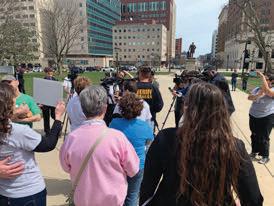

Also in the State of Michigan, animals are considered personal property (chattel) which ultimately can add to the neglect of abused animals. “If a person refuses to give up his property (the animal) then, the animal will be caged in a facility for the duration of the trial process,” explains Swanson. Trials may last years, prolonging the animal’s suffering. Should the ballot initiative pass, that loophole would be closed and allow animals to be placed in a good home after limited period. In addition to the animal’s suffering, the loophole provides a drain of society funds and efforts. “We rescued 36 dogs from a dog-fighting ring and currently, they are in cages at Animal Control,” tells Swanson. “It costs roughly $20 per dog per day to house them. That’s $720 per day. To date, nearly $74,000 has been spent sheltering these animals with no end in sight.”
suffering animals; for example, those that may be sick or injured beyond help. “The courts will allow for interpretation of a situation,” says Swanson. For example, there is a difference between ending an animal’s life humanely versus bludgeoning it to death with a blunt instrument or starving it to death. The courts will decide.
Identifying those who abuse and mistreat animals is much more serious than first thought. Proving to people that there will be accountability for such actions can help deter future violence. “There is a relationship between animal abuse and violence against people,” states Swanson. Animal cruelty is a known predictor of future violence including rape, murder, arson, domestic violence and child sexual abuse. Statistics show that 75% of abused women report a history of their animals being threatened or harmed by their intimate partner. From 1988 to 2012, it was found that 43% of school shooters had histories of animal cruelty. The possible impact of the initiative goes far beyond animal abuse.
Protect MI Pet kicked off in April on National Pet Day with hopes of gaining enough support to be included on the November ballot and the PROTECT MI PET KICKED OFF ON APRIL 11, NATIONAL PET DAY, WITH HOPES OF GAINING ENOUGH SUPPORT TO BE INCLUDED ON THE NOVEMBER BALLOT.
Swanson also assures that there will be allowances for humane euthanasia of
initiative needs all the help it can get. “There are two ways to get on the ballot,” says Swanson. “One is to get enough petition signatures and the second is via legislative vote. We are pursuing both – these animals cannot wait.” The initiative will need 500,000 petition signatures in 180 days to be placed on the ballot. Sheriff Swanson and his team have made a stretch goal of 750,000 signatures to ensure they exceed the requirement.
Protect MI Pet is hoping for robust support. If you
would like to become a volunteer, donate to the cause, or find more information, please visit protectmipet.com. Please stay informed to add your signature to the petition when the time comes and, of course, to vote “YES” in November.
“It’s estimated that the initiative has a 87% chance of passing if it is able to find its way onto the ballot,” says Swanson. “Animals cannot testify or voice their pain. It’s up to us to help them.”
Help Protect MI Pet end the cruelty. Visit Protectmipet.com ◆
“Animals cannot testify or voice their pain. It’s up to us to help them.”
Sheriff Chris Swanson


BY PETER HINTERMAN
In2016, Johnell Allen-Bey had an epiphany. While incarcerated serving out a multi-year prison sentence, a former cellmate and friend who did his time and was released had returned to the correctional facility to give a presentation to the inmates. At first, Allen-Bey hadn’t planned to attend but his friend, Ronald Simpson-Bey, specifically requested that he be there. “He asked for me, so I went
– and it was a life-changing moment,” he recalls. “To see someone I knew who was making a difference in the world and changing things for the better made me really think of possibly being free again and what I could do.” Simpson-Bey was fighting for equality for formerly incarcerated persons with Nation Outside, and Allen-Bey felt it was a cause he could believe in.
After spending 29 long years in a correctional
facility, Allen-Bey was released in 2018 and he wasted no time. He started his own company, Johnell’s Transportation, became co-owner of J&J Home Improvements, began working as a life coach with Re-Connect My Life and as a motivational speaker. He embedded himself in the Flint community serving on numerous boards and in neighborhood projects, and forged relationships with the Genesee County and Washtenaw Sheriff departments.
Allen-Bey, with friend Percy Glover and in partnership with Sheriff Christopher Swanson, started the I.G.N.I.T.E. inmate education program. A busy and motivated man, Allen-Bey is constantly working toward a goal, so it became obvious that he would join the Nation Outside organization, co-founded by his friend Simpson-Bey, and serve as its Flint Regional Coordinator. “Nation Outside gives a voice to the voiceless,”
explains Allen-Bey. “We organize, mobilize, support and advocate for changes to help formerly incarcerated people and their families. We want to enhance their capacity to shine.”
“Nation Outside looks to do two things,” adds Nation Outside Director Ashley Goldon, “drive policy and practice innovation. In other words, we advocate for legislation changes that will eliminate barriers to success for the justice-impacted and support them.”
Nation Outside is unique in that it is an organization operated entirely by formerly incarcerated people. The Flint Chapter is the biggest in the state. The staff has over 350 years of lived experience with correctional institutions and represent over two million families impacted by the justice system state-wide.
“We are run by returning citizens,” says Allen-Bey. “It’s
something we truly understand.” This shared background leads to direct knowledge and experience with the multitude of barriers that exist for returning citizens. Current Nation Outside campaigns are focused on addressing each barrier in turn, now and in the future.
On October 13, 2020 the Clean Slate Package was passed in Michigan allowing for expungement of lesser felonies and misdemeanors from a person’s record after a determined time period. In 2021, Nation Outside executed the largest expungement fair in Michigan’s history.
“In two days, nearly 4,000 people showed up,” states Goldon. “We only expected to help around 2,000.” Not every felony is available for expungement; major offenses such as a murder conviction cannot be expunged. Offenses eligible for expungement include marijuana offenses
and lesser felonies. “Many expungements are for traffic violations,” Goldon explains. “There is no notification to returning citizens that this is possible. Part of our work is to get the word out.” In Flint, Allen-Bey has been vocal about the expungement process since day one and has held numerous expungement fairs. “We’re looking to do it monthly,” he says. The expungement process is the key to more than just clearing a record. It clears the way to obtaining better housing and employment where the stigma of having a misdemeanor or felony conviction can keep a returned individual poor and homeless. “The stigma associated with incarceration is maybe the biggest barrier,” says Goldon. “It affects
“Nation Outside gives a voice to the voiceless. We want to enhance their capacity to shine.”
Johnell Allen-Bey
Flint Regional
Coordinator
us in every way including employment, education and housing. A person can’t focus on anything else if their basic needs aren’t being met.”
To address this barrier, Nation Outside voices support of numerous “ban the box” policies (the ‘box” referring to a housing or employment application that asks if a person has been convicted of a felony), including their push for fair chance housing and hiring. “In Flint, we worked with Hurley Medical Center and they now employ the formerly incarcerated,” says Allen-Bey. “We worked with Washtenaw and Genesee County Sheriff’s offices and they are the only →



two in the state that employ felons.” Golden adds, “We are looking into ways to make hiring felons more attractive to business owners. Incarceration has been classified as a social determinant of health, and so we are pushing to include Medicaid in the employment process.” Besides their work with housing and employment, Nation Outside provides help and advocates for returning citizens who would like to attend college through fairness in admission forms and procedures, provides mentoring and support, and helps with workforce training and certifications.
Another large piece of the puzzle is civic engagement and empowerment. “We push for our returning citizens to be civic-minded,”states Goldon.
“We work to give them the tools to impact policy and be a part of their community. Voter disenfranchisement is a big issue in the incarcerated community; we want them to exercise their power, to show up to the city council meetings, to be knowledgeable and to vote.” Allen-Bey has embraced the message thoroughly and spreads it to other returning citizens in Flint.
“Most people don’t know that released felons can vote in the State of Michigan,” he states.
“When a person is released from prison, they are automatically registered to vote.”
In fact, in Michigan, those on probation, on parole or in jail waiting to be sentenced are eligible to vote. “We went to the jail in Flint and helped them complete the process. In the

“We advocate for legislation changes that will eliminate barriers to success for the justice-impacted and support them.”
Ashley
Goldon Director past, many were denied their chance,” says Allen-Bey.
Ashley Goldon, Johnell Allen-Bey and the others at Nation Outside continue to tirelessly work to achieve fairness for the nation’s nearly 80 million justice-impacted people through presence and programming. In Genesee County, Allen-Bey continues to support the formerly incarcerated in every way he can. “First, I’d like to thank the Ruth Mott Foundation. They have supported everything we have done from day one,” says Allen-Bey. “Genesee County has over 369,000 formerly incarcerated people and we are all impacted by the barriers they face. Nation Outside is a
movement to show the world that we can all move forward together and that we belong.”
Incarceration knows no race, age, sex or religion – it impacts us all. Nation Outside is looking for members and support. If you believe in the mission and would like to help returning people find their way to better lives and better communities, visit nationoutside.org and donate or get involved. Membership is open to everyone and anyone. For information about future events and policy information and/or to volunteer, reach out via email or social media on Facebook or Twitter. ◆



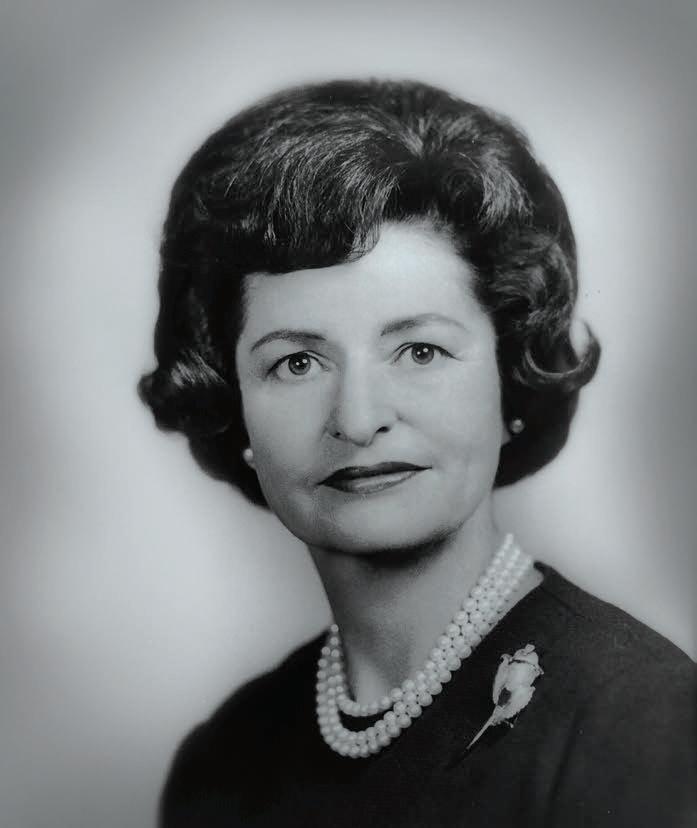
BY AMIR E. ABU-AITA & ALEXANDRA NASSAR
Lady Bird Deeds, also known as Enhanced Life Estate Deeds, were first created and used in the state of Texas by attorneys in the late 1980s. They were named after Claudia Alta “Lady Bird” Johnson, the wife of former U.S. President Lyndon B. Johnson, who passed away in 2007.
This type of real estate deed allows property owners to transfer property to a named beneficiary at the owner’s death while retaining the right to use and enjoy the property during their lifetime. Unlike traditional life estate deeds, Lady Bird Deeds provide additional benefits to the property owner, including the ability to sell, mortgage or even revoke the deed during their lifetime.
The Lady Bird Deed has become popular because it provides a way for property owners to avoid probate and minimize the risk of losing their property to Medicaid estate recovery. It is also a useful estate planning tool for those who want to pass on their property to a loved one while retaining the right to use and control it during their lifetime.
A relatively simple document, the Lady Bird Deed is executed by the property owner and recorded in the
county where the property is located. The deed names the property owner as the “grantor” and the named beneficiary as the “grantee.” It also includes a legal description of the property and states that the grantor retains a “life estate” in the property, which means they have the right to use and control the property during their lifetime.
The Lady Bird Deed differs from a traditional life estate deed in that it allows the grantor to retain certain powers over the property during their lifetime. For example, the grantor can sell or mortgage the property without the consent of the named beneficiary. The grantor can also revoke the deed at any time during their lifetime, which means that they can change their mind about who will receive the property at their death.
One of the primary advantages of the Lady Bird Deed is that it allows property owners to avoid probate, which is the legal process of settling an estate after someone dies. Probate can be time-consuming and expensive, and it can also result in the loss of some or all the property to Medicaid estate recovery. By using a Lady Bird Deed, property owners
can ensure that their property passes directly to their named beneficiary without the need for probate.
Another advantage of the Lady Bird Deed is that it can help to protect the property from Medicaid estate recovery. Medicaid is a government program that provides healthcare benefits to low-income individuals and families. When a person receives Medicaid benefits, the government may seek to recover the cost of those benefits from their estate after they die. This can help to minimize the risk of losing the property to Medicaid estate recovery.
In summary, a Lady Bird Deed is an extremely useful and simple tool to help protect your estate. It is important to understand that laws change all the time. Although a Lady Bird Deed is a valid document according to the laws in the State of Michigan, the law may change deeming these types of deed invalid. It is important to consult with a licensed attorney in your jurisdiction who specializes in estate planning to determine whether a Lady Bird Deed is the right estate planning tool for your individual needs. ◆

Amir E. Abu-Aita practices Elder Law, Medicaid Planning, VA Planning, Probate, Estate Planning, Business Transactions, and Assisted Living Law. He is a member of the Genesee County Bar Association as well as the Elder Law and Probate Sections of the State Bar of Michigan. In addition, he serves as a member of the Genesee County Commission on Aging, Adult Foster Care Providers, and Former President of Elder Abuse Alliance (Formally known as the Elder Abuse Task Force). He has been selected to the Michigan Super Lawyers® 2021-22 Rising Stars list. Each year, no more than 2.5 percent of the lawyers in the state are selected by the research team at Super Lawyers® to receive this honor. He has also been selected for the 2022 Best Lawyers: Ones to Watch in America™ for his high-caliber work in Elder Law and Trusts and Estates.

Alexandra Nassar specializes in Wills, Trusts & Estates, and Probate Law. As a member of the Greater Flint Community her whole life, she is dedicated to serving the community. Alexandra serves on the boards of the American Inns of Court, McLaren Regional Medical Center Bioethics Committee, Genesee County Bar Association Membership Committee, and the Arab American Heritage Council. She was named a Rising Star by Michigan Super Lawyers® in 2016 and 2017 and is an Institute of Continuing Education (ICLE) Contributor.
BY PETER HINTERMAN
Allwas quiet as Margarette Eby approached the entrance to Applewood Estate. She stopped her vehicle but left the engine running as she got out to open the gate leading to the gatehouse where she lived for a blissful and industrious five years in Flint working as provost and music professor at the University of Michigan-Flint. She shivered as she opened her car door and stepped out. The day had become increasingly cold as it waned and the temperature at that time of night hovered just above freezing. The light jacket that provided more than enough warmth during a day spent with friends downtown was no longer adequate. She quickly felt in her pocket for the key but realized she needn’t have bothered; the gate was standing ajar. She opened it fully, stepped back into her car and continued up the drive. It was a long day but a good one and after enjoying dinner with friends, she wanted nothing more than to relax in the warmth of

her home for a few hours before officially retiring for the night, readying herself for another full day at the University. She turned off the car and stepped once again into the cold night. The sky was overcast, obscuring all moonlight and threatening to cover the ground in the year’s first blanket of snow. She fumbled with her keys, straining her eyes in the darkness to find the right one as she approached the front door but found, again, that a key wasn’t needed. The door opened with a simple click. Did she leave it unlocked when she left earlier? She stepped inside, switched on the light, then closed and locked the door securing her inside. She removed her jacket, hung it up and moved into the kitchen. As she opened the cabinet to get a cup for tea, she heard a thump from the next room and then another. She froze, afraid to turn and look. She heard footsteps and then, a shadow moved into the corner of her eyesight. Margarette Eby wasn’t alone …



On November 9, 1986 the City of Flint woke up in shock and horrified. Margarette Eby, the beloved music professor and founder of the city-wide Basically Bach Music Festival was found dead, murdered in her home at Applewood Estate. The crime scene was grisly; police determined that Eby had been raped and stabbed to death the night before. There were no signs of forced entry and the only evidence the killer left behind was a single fingerprint found on a faucet knob in the bathroom where the killer cleaned up after the deed. In the months and years that followed, detectives exhausted all leads while a city and family mourned. Margarette Eby was beloved both at the University and in the city she had adopted. In the investigation, all paths led to dead ends and the case was forgotten by everyone except those who clung fast to Eby’s memory.
On February 18, 1991 Nancy Ludwig arrived in Romulus, MI and checked
into the Hilton Hotel.
A flight attendant with Northwest Airlines, Ludwig was no stranger to the city or her accommodations. Around 9pm, she opened the door to a room where she had stayed countless times. It felt so routine, she had no reason to be wary. Suddenly, a man emerged from a nearby stairwell, grabbed her from behind and forced her into the room at knifepoint. Just after noon the next day, a member of the housekeeping staff found Ludwig’s body lying on the floor, hands bound behind her back. Her throat was slit ear-to-ear. The coroner determined that Ludwig had been stabbed multiple times, including wounds on her hands she sustained while fighting her attacker. Examiners also determined that she had been raped multiple times. Police found little evidence of her killer with the exception of fluid DNA and a bloodsoaked washcloth left in the sink. As with the Eby
case in Flint five years prior, detectives were facing an uphill battle. Besides the scant physical evidence at the crime scene, they also were able to get a sketch of a possible suspect from witnesses in the hotel parking lot who saw a suspicious man loading baggage into a Monte Carlo nearly an hour after Ludwig was murdered. All roads went nowhere and the case went cold until five years later, when Ludwig’s husband Art received a phone call from the son of Margarette Eby. After reviewing details of Nancy’s death, Eby’s son told Art he believed both Nancy and Margarette were killed by the same person. They reviewed notes and, convinced, Art called Romulus Police, who told him that they would look into it further. In 2002, detectives reprocessed the fingerprint found in Margarette’s bathroom and this time, they got a hit from the database. The fingerprint belonged to Genesee County resident, Jeffrey Wayne Gorton.
Jeffrey Wayne Gorton came to Michigan from Florida in 1985. While serving in the Navy in Florida, he was arrested for attacking women on the base. His method of operation was to follow them, bash them in the back of the head, and steal their undergarments as they struggled to gain their senses. He posted bond for release from jail but was quickly arrested again for breaking and entering. He was tried, convicted and sentenced to four years behind bars, but released after serving two years.
Once out of prison, Gorton moved to Genesee County and began working for the Buckler Automatic Sprinkler Company owned by his parents. The company provided service to the Applewood Estate in Flint and Gorton frequently worked there. At work, he gained a reputation for having misogynistic and extremely perverse views toward women. Despite being dubbed “Uncle Perv” by his coworkers, Gorton eventually married and fathered two children. In fact, it was at an outing with his family where investigators obtained the evidence that had eluded them for so long. →

After reopening the case, investigators finally had a name to go along with the fingerprint left at the scene of the Eby murder; but, being an employee on the grounds at Applewood Estate at the time the crime was committed, it was possible that Gorton could have been in that bathroom during his workday. It was determined that more evidence was needed for a conviction.
Convinced that Gorton had committed both murders, investigators began to track him in an attempt to obtain DNA to match the sample found at the Ludwig crime scene. They followed him to a skating rink where he spent the night with his family, skating and eating dinner. There, investigators were able to retrieve his drinking cup and get a sample of saliva from the rim. The saliva was found to contain two different DNA sources, meaning the cup was shared. However,

one source matched the DNA from the Ludwig evidence.
With this new evidence in hand, a warrant was obtained to search Gorton’s home. There, investigators found strange items including hundreds of pairs of women’s underwear and lingerie, some tagged with the original owner’s name and description. It seemed Gorton had been continuing the criminal activity he started in Florida years earlier.
When questioned by police, Gorton refused any wrongdoing and even denied ever
having been in Eby’s bathroom, thereby eliminating any legitimate reason for his fingerprint to be found there which helped to solidify the prosecutor’s case against him. Even when confronted with all the evidence, Gorton maintained his innocence and refused to confess.
The matter of The People of the State of Michigan vs Jeffrey Wayne Gorton was tried by jury in 2004. Charged with the rape and murder of both Margarette Eby and Nancy

Ludwig, the 39-year-old was convicted of criminal sexual misconduct and first-degree murder in the death of Nancy Ludwig. Rather than go through another trial, he later pled guilty to killing Margarette Eby. Wayne Circuit Court Judge Maggie Drake sentenced Gorton to life in prison without possibility of parole. He continues to serve his sentence today in Ionia, MI.
While the monster who took the lives of Nancy Ludwig and Margarette Eby is behind bars, police believe
that the two women may be only the tip of the iceberg. While taking Gorton’s history into consideration, police believe the number of his victims could be much higher; barring a confession, we will probably never know and he may never have been caught if it weren’t for the gut feeling of Eby’s son who grieved the loss of one of Flint’s finest citizens, Margarette Eby. ◆


BY MARK SPEZIA

During high school, Rachel Phillpotts honed her soccer talent on the turf at refurbished Atwood Stadium. There, the Linden native was part of powerful Powers Catholic teams and concluded her prep career in unforgettable fashion, playing an integral role on the Chargers' dominant 2017 team which captured a Division 3 state championship and finished 26-1-2.
After being named to the All-State Dream Team, Phillpotts took those talents to the University of Wisconsin-Milwaukee, helping the Panthers to four Horizon League titles and four NCAA Tournament berths. Along the way, she was named the Horizon League's Defensive Player of the Year and to the all-conference first team three times. Phillpotts spent most
summers back in Michigan, further sharpening her skills with pre-professional teams like Lansing United and, for the past two years, Detroit City FC.
This spring, Phillpotts returns to the scene of her high school triumphs, joining Flint City AFC for its second season and first under a new coaching staff led by Michele Krzisnik. The allure of playing at Atwood again in front of family, friends and the club's ardent supporters was too strong for Phillpotts to resist.
"I’m excited about the opportunity to play competitive soccer closer to home," says Phillpotts, one of the team’s five
Flint-area players. "Atwood was my home in high school and it'll be fun to play back on the same turf again. I am also looking forward to playing with competitive, high-level athletes to create a winning environment."
High-level talent, indeed.
Of the 30 players on this season's roster, 12 have earned some type of college all-conference honor and all but one has played, is playing or will play at the NCAA Division 1 level, meaning Flint City AFC should have little trouble bettering last season's 2-9-1 USL W League record.
PHILLPOTTS
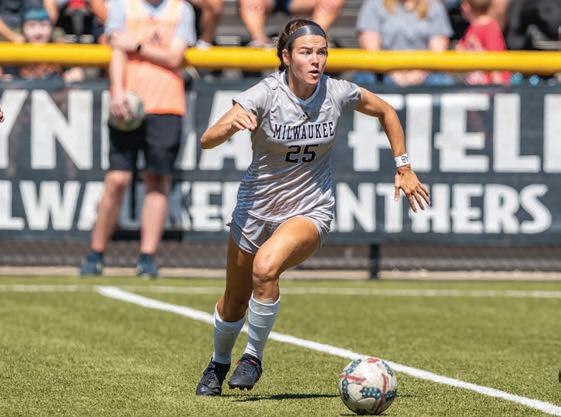
Phillpotts started 72 of 82 games at UW-Milwaukee, finishing with 15 goals, including five game-winners, and 12 assists. She was also part of an unforgiving defense which allowed a miniscule 0.48 goals per game.
Playing in front of hometown fans is not the only thing Phillpotts is looking forward to. She is elated to be playing with cousin Grace Phillpotts at Atwood for the first time after both spent the past two seasons with Detroit City FC.
"Playing with Grace is always an exciting opportunity and we both share a passion for the game and competing with family on the same team is something special," Rachel says.
Grace, a Fenton native, recently transferred to Kentucky after three seasons at DePaul University where the defender was named to the All-Big East Freshman team in 2020. Not only will she continue to be Rachel's teammate, she is also reuniting with former teammates from the elite, Livonia-based Michigan Hawks club she played for while in high school. Krzisnik has coached Hawks teams for more than 25 years, including two national finalist

squads, and serves as the organization's director of scouting.
"I’m really looking forward to playing with and for my old teammates and coaches and continuing to play with Rachel in front of our family and friends," Grace says. "I know this program has a lot to offer and I can’t wait to be a part of it."
Familiarity on several levels is bound to be a major strength for this season's squad.
In addition to the Phillpotts cousins, there are two sister duos – Fenton's Madi and Landis Canada and Celia and Justina Gaynor – who are also Michigan State teammates. There are two other pairs of current college teammates, including former Grand Blanc All-Stater Jenna Blackburn and Madi Canada (Western Michigan) and Regan Dancer and Ella Offer (Xavier).
The most common thread is that all but five players have been members of the Hawks and all 25 have been coached by Krzisnik or new Flint City AFC associate head coaches Doug Landefeld and Adil Salmoni.
Landefeld, a former Michigan State captain who has been with the Hawks
for nearly 30 years, has coached three of its teams to national titles and now serves as executive director. Salmoni joined the Hawks about 15 years ago and is technical director. He has also coached United States U16 and U18 national teams.
The trio, who will continue in their Hawks roles, began their duties in January.
"It's been mostly about gathering all the players and assembling our roster since we started," says Krzisnik, a second-team All-Big Ten performer and captain at the University of Michigan who also helped Livonia Stevenson to the 1990 Class A state title. "We have good numbers and good talent and many players who are familiar with each other because our Hawks club is like family. Still, many are coming from different college programs, so we'll see how quickly they come together and fit with each other."
Being able to work with players beyond the youth level, including so many they previously coached, was a major reason the three agreed to lead Flint City AFC.
"We really wanted to work with players who came from the top end of our program and other college players to
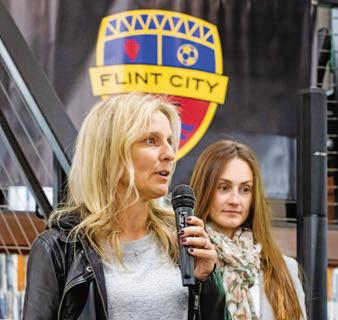
LAST YEAR, FLINT CITY AFC HAD A COLLECTION OF GOOD PLAYERS, BUT THIS YEAR WE'LL BE MORE OF A TEAM."
COACH

help them continue their development," Landefeld says. "We are excited about helping (team president) Costa Papista and (co-owner) Eddie Hudson continue moving the organization forward from the ground floor to the pinnacle of success."
In all, 13 players who spent at least one game with Flint City AFC last season return, including Blackburn, who had three goals and an assist in three games. She has played in 44 games the past three seasons, starting 34, with 11 goals, three game-winners and six assists.
"Playing with Flint City AFC last year and representing Flint was such a blast," she says. "The environment the fans created was great. Our experience from playing in the USL W last year and having so many players back will help us be very successful."
Madi Canada, a midfielder, made the MAC All-Freshman team last season, starting 17 of 19 games and playing an average of 79 minutes. Landis, a Fenton High School junior and midfielder, plays for the Hawks and was named to the Elite Clubs National League's Midwest
Conference U-16 first team last season. She has committed to Missouri.
Other returning college all-conference players are forwards Regan Dancer, Abby Werthman (Western Michigan) and Sammi Woods (Michigan), midfielder Justina Gaynor and goalkeeper Kayla Shuk (Aquinas College).
Gaynor made first-team All-Big Ten, the Big Ten All-Tournament team and all-region second team last fall as the Spartans finished 17-3-3, captured a Big Ten title and reached the second round of the NCAA Tournament. She started all 23 games, finishing with four goals and two assists and contributing to a defense that allowed a mere 0.65 goals per game.
Shuk played the most minutes in goal (452 in five games) for Flint City AFC last season as she prepared for her freshman season at NAIA Aquinas. She was named second-team All-Wolverines Hoosier Conference.
Other returnees are midfielders Jaden Frigerio (Bowling Green), Celia Gaynor, Olivia Rush (Indiana) and Remini Tillotson (TCU) and forwards Maya Carter (Virginia) and Olivia

Thomas, a high school senior and firstteam U17 ECNL Midwest pick who is committed to North Carolina.
Flint City AFC's other college all-conference picks are University of Miami graduate Shannon Browning (defender), Ball State's Delaney Caldwell (forward) and Wisconsin's Aidan McConnell (defender).
Browning, the most senior member of the team at 28, will play and coach. The All-Athletic Coast Conference pick was a three-year team captain at Miami, finishing with a goal and eight assists. She then played overseas before joining Detroit City FC.
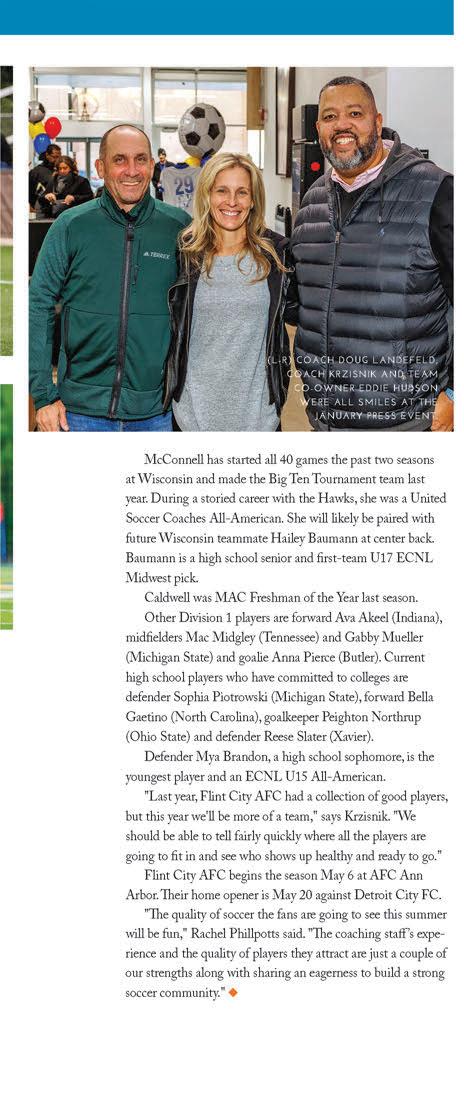





BY SHANE JACKSON, CHHC, BSCJ, MSCJ, PH.D.
Believe it or not, the foods you consume can play a major role in your overall state of mind. So if you are looking for ways to boost your mood and feel better overall, read on!
Many of us know that nutrition directly impacts our physical health, but did you know that it also significantly influences our mental health? Making simple dietary changes can drastically affect the way you think and feel. In fact, certain foods and nutrients have been said to reduce symptoms of depression and anxiety, as well as improve overall mental well-being. Examples of these
powerful tools include leafy greens, fatty fish, colorful fruits and vegetables, nuts and seeds, probiotics such as yogurt or kombucha, and essential vitamins and minerals like magnesium or B vitamins. We all have an opportunity to better our mental health simply by making positive dietary choices!
Eating the right foods can make a huge difference in your ability to stay alert, think clearly and concentrate. Essential nutrients like protein, Omega-3s and B vitamins are key
for keeping our brains healthy and sharp. Foods rich in these nutrients can help us maintain balanced moods and improve our memory. Fatty fish, nuts and seeds, eggs, dark leafy greens, wild blueberries, beets, whole grains and avocados are recommended for their proteins, healthy fats, vitamins and minerals, which aid in boosting cognitive ability along with providing essential building blocks for brain function. If you want to sharpen your focus and reach peak performance while boosting your mental health, packing your diet with these superfoods may be the remedy.

The oils of mackerel, tuna and salmon are loaded with the essential fatty acid, Omega-3 – essential for improving mental health and emotional stability. These fatty acids have been scientifically proven to help reduce the risks of depression, panic attacks and stress and provide an array of other mental health benefits. There’s a reason why it’s so widely recommended to consume these sources of Omega-3 fatty acids on a regular basis: they really can make a huge impact on one’s mental well-being.

Healthy fats and protein help contribute to improved mental health. Both walnuts and almonds contain polyunsaturated fatty acids that have been found to improve mood and cognitive function, while pumpkin, sesame and flax seeds offer essential minerals like zinc for enhanced brain activity. Eating nuts as part of a balanced diet can also lower cholesterol levels, which is helpful in reducing anxiety over time. Nuts and seeds can be incorporated into both sweet and savory recipes from muffins to salads, for delicious meals with extra mental health benefits.
When it comes to supporting mental health, leafy greens are an excellent choice. Popeye wasn't wrong – these nutrient powerhouses deliver vitamins and minerals that can help boost mood and increase energy levels. Leafy greens can range in variety from spinach to arugula, kale and bok choy, each with its own unique nutrition benefits – but each is a great source of folic acid, iron and vitamin C. Eating leafy greens on a regular basis can slow cognitive decline by 30%, and is associated with greater happiness and overall mental well-being. All it takes is one cup a day for maximum resilience against anxiety and stress.
Our brains are 85% water, so it's no surprise that drinking enough fluids daily can improve mental performance and cognitive abilities. Low levels of hydration often lead to difficulty concentrating, memory problems, low energy, mood swings and a weakened immune system. Staying hydrated helps flush out toxins and replenish vital electrolytes needed for optimum brain function.
Vitamin D is often referred to as the “Sunshine Vitamin” and for a good reason – it's produced in our skin when

exposed to UV rays from the sun. Vitamin D has been linked to improved mental health, including reduced anxiety and depression symptoms, and can be found naturally in foods like oily fish and eggs. For those living in more northerly climates where sunlight is sparse during the winter months, supplementing with a vitamin D pill can be beneficial to maintaining a healthy mind.

When it comes to mental health, what we put into our bodies can be just as important as the activities we do. Eating a nutritious diet is an easy way to improve your mood and outlook on life. To boost your mental health, consider avoiding sugary desserts and snacks, processed meats and artificial sweeteners. Eating unprocessed, whole foods rich in proteins, healthy fats, and fiber is one of the best ways to get essential nutrients that can help reduce stress, increase energy levels and even improve sleep quality. Try incorporating more leafy greens into your diet such as kale and spinach, as well as healthy sources of carbohydrates like oats, quinoa and sweet potatoes – all of which have been linked to improved mental health.


alertness, improved concentration and better mood. Thus, while it’s important to be mindful when consuming these beverages, some amounts can be beneficial as part of a balanced diet.


These food choices often accompany activities such as watching TV, using the computer, eating in a restaurant or grabbing a snack on the go. While these items may provide short-term satisfaction, they negatively impact our overall health. Cutting down on sugar-sweetened beverages such as sodas and specialty coffee drinks can help reduce weight gain and decrease your risk for type 2 diabetes. Depending on the ingredients, processed snacks contain high levels of sodium and sugar. Improving your diet by reducing or eliminating sugary drinks and processed snacks is a great way to start looking after your mental health through better nutrition.
It is widely known that alcohol and caffeine can have adverse effects on our mental health, so it's important to consume them in moderation. However, monitoring your intake isn’t always easy. A good rule is to limit alcoholic drinks to one or two per day and no more than four or five drinks per week. On the other hand, caffeine can offer benefits when consumed in moderation – up to 400 milligrams daily – as it has been associated with increased

When it comes to nutrition and mental health, there are certain foods that can help support improved overall well-being. Incorporating key nutrients such as omega-3 fatty acids, B vitamins and minerals, probiotics, antioxidants, amino acids and magnesium into your daily diet will aid in reducing anxiety levels and improving mood. Having healthy eating habits is one of the most important things you can do to improve your mental health. One way to ensure you get sufficient nutrition is to plan meals ahead of time, including foods that are both nutritious and satisfying. Eating a balanced diet with a mix of plant-based proteins and fruits and vegetables packed with vitamins and minerals will keep you feeling physically and mentally energized throughout the day.

With a combination of protein, fiber and multiple micronutrients from plant-based sources like legumes, fruits, vegetables and whole grains as a starting point for good nutrition, you can positively impact both your physical and emotional health. Eating more nutrient-dense foods containing high amounts of essential vitamins, minerals and omega-3 fatty acids helps support brain function and overall mental well-being. A balanced diet helps boost serotonin levels for healthy emotional responses to stress, releases hormones that promote healing and restoration during sleep and prevents excessive inflammation caused by unhealthy foods or overeating.
Making wise dietary choices has lasting effects on your emotional state and overall health; it is an effective form of holistic self-care that supports the mind, body and soul.
Based in Flint, MI "Your Favorite Health Coach" Shane Jackson is a professional nutrition specialist with a vast scope of experience. She is a multi-skilled and diversely talented professional with a strong inclination toward self-improvement, human psychology and overall personal health. She has an extensive nursing background as well as a Master's Degree in Social Science and Criminal Justice from Michigan State University as well as a Ph.D. Currently, Jackson is a Community Nutrition Instructor at MSU. She has published four recipe books and her first children's book, Rainbow Power, is scheduled for release in the summer of 2023.



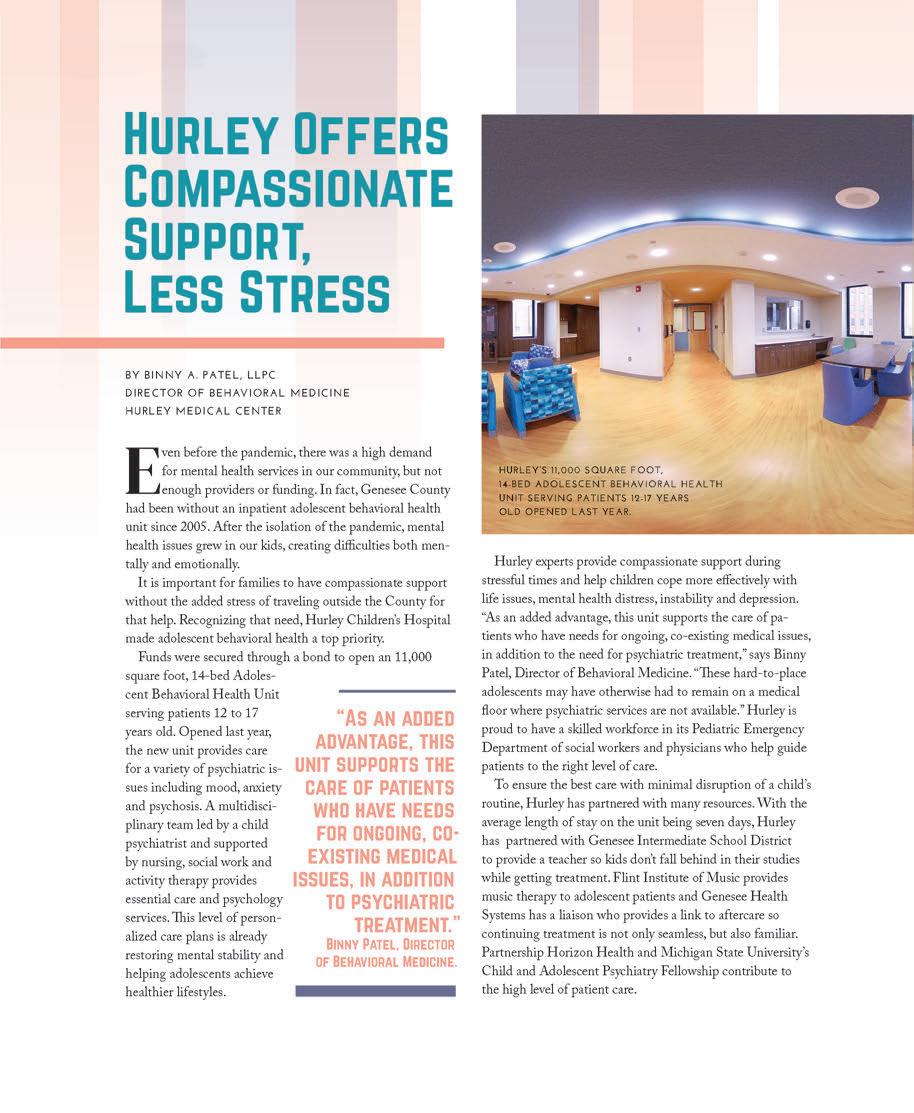




RIVERFRONT CONFERENCE CENTER | 3.23.2023
Hundreds of people gathered in Downtown Flint for an early breakfast with the purpose of honoring those who strive to make a difference in a young person’s life – individuals, businesses, government agencies and organizations. The event is an annual fundraiser for Voices for Children, which works to help victims of child abuse in Genesee and Shiawassee Counties. Sharing the emcee dutiess were Voices for Children Board Member and ABC12 News Anchor, Angie Hendershot, and Genesee County Sheriff Chris Swanson. Congratulations to all honorees! ◆
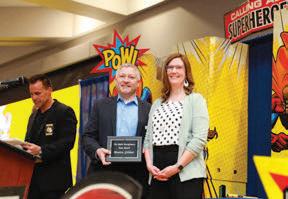







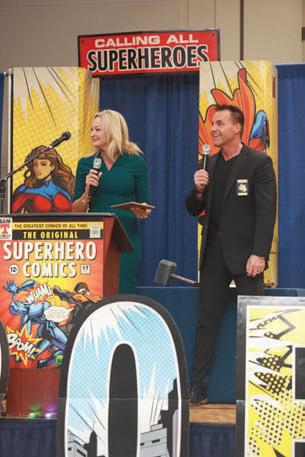

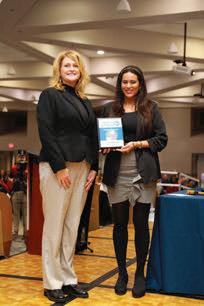

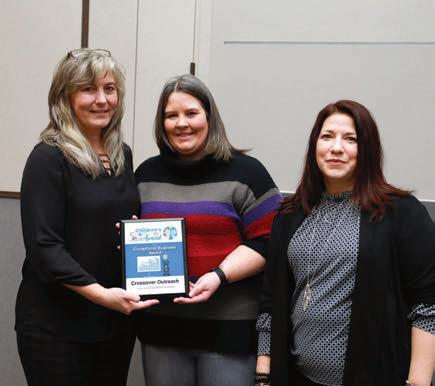



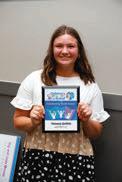

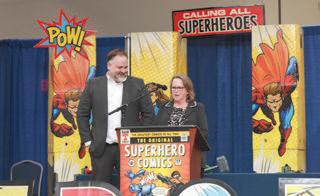



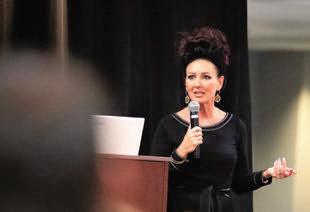
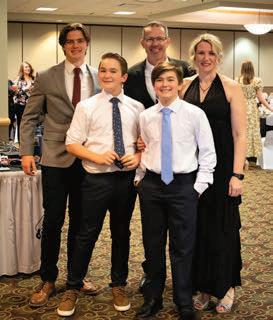


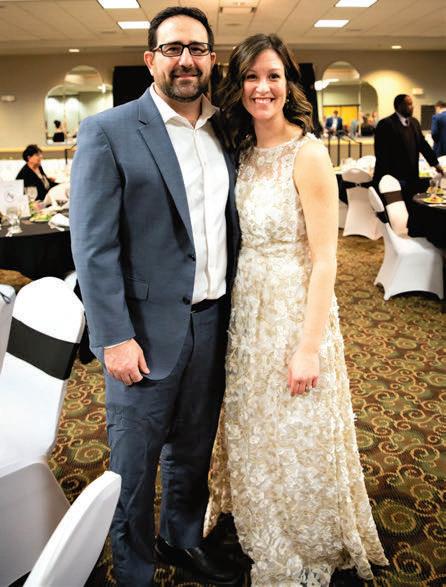
GENESYS CONFERENCE & BANQUET CENTER | 3.24.2023
Photos By Deborah Gillespie, Anavista Photography
This annual event gathers community members to raise support and funding for the Prism Project Safehouse Program, which provides restorative care for child survivors of sex trafficking. Emceed by Pastor Bernard Drew, the agenda included Keynote Speaker Rev. Christina Tipton. The focus of the evening was to shine the light on the darkness of sex trafficking and provide preventative education. Over $58,400 was raised to further fund the Prism Project’s efforts. (For more about the Safehouse Program, see p.14.) ◆
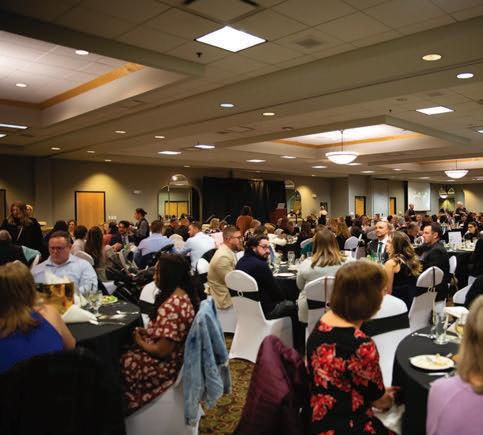




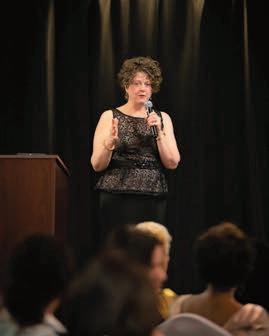
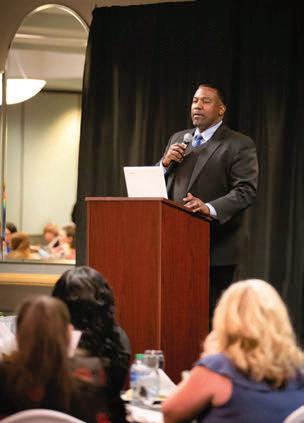
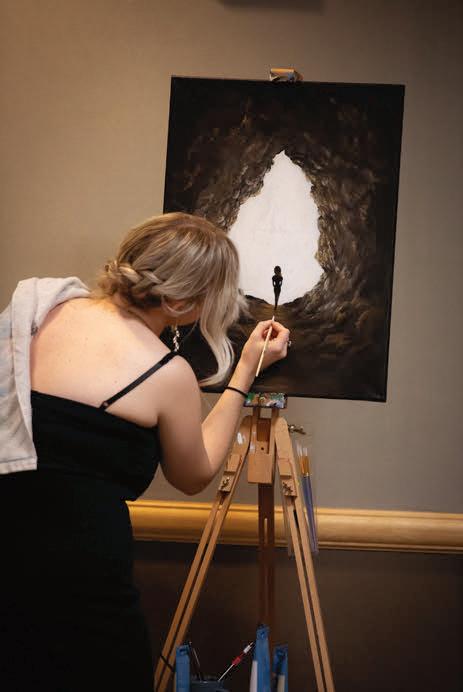
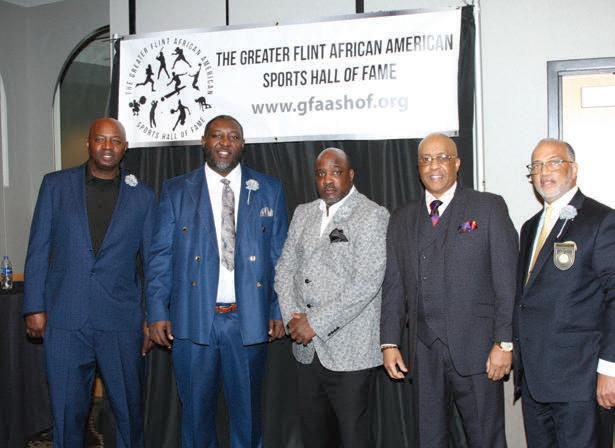


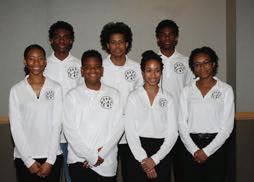







GENESYS CONFERENCE & BANQUET CENTER | 3.26.2023
TheGreater Flint African American Sports Hall of Fame 2023 Induction Class was celebrated with a reception and dinner attended by friends and family of this year’s esteemed honorees. Ira Rutherford presided over the induction of Marty Embry (Basketball), Anthony Holliday (Coaching), Tim Littles (Boxing), Kelvin Torbert (Basketball), Andre Wiley (Basketball), Yvonne Thompson (Basketball), Fernando Smith (Football) and Robaire Smith (Football). The goal of GFAASHOF is to “preserve and exhibit the history of former Flint African American professional, college, city, high school and sandlot players and teams from as early as possible and into the future.” Congratulations to all! ◆
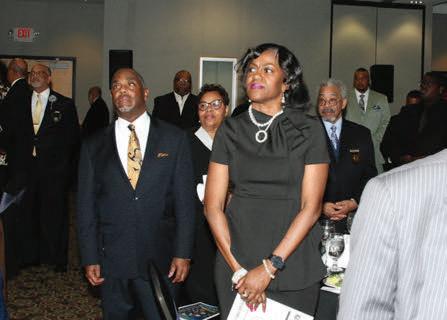




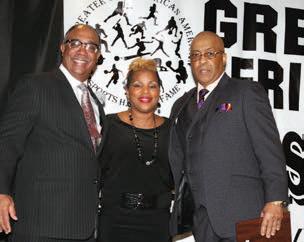





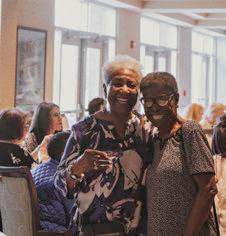





THE HOSPITALITY HOUSE AT MCLAREN | 4.14.2023
Photos by Jaden Moxlow
Agroup of girls gathered for a night of fun, food, fashion and pampering to help families in need. Attendees enjoyed a fashion show, wine tasting, Painting with Carla, makeovers, mani-pedis, facials, line dancing, massage, a goody bag and more. Proceeds will directly support patients and families who utilize The Hospitality House at McLaren – a home-away-from-home for patients and their caregivers who travel to Flint for healthcare.The Hospitality House asks guests for a small donation to cover the cost of each stay; however, one in four guests require financial assistance. This fundraiser helps cover accommodations for those in need, as well as providing food, toiletries and other items. ◆


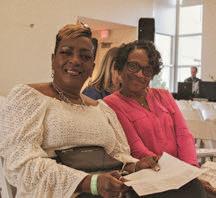






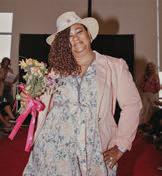

Thissold-out fundraiser featured local food, cocktails, ciders, wine and beer served up by Genesee County’s favorite chefs and brewers. The fourth annual event included a silent auction (also online) with proceeds supporting Sloan Museum of Discovery and Longway Planetarium’s outreach initiatives and daily operations. The funds raised also help open doors to thousands of underserved kids so they can experience science and history programs at these exciting and engaging facilities. ◆


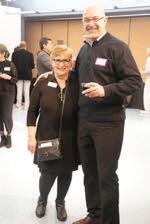






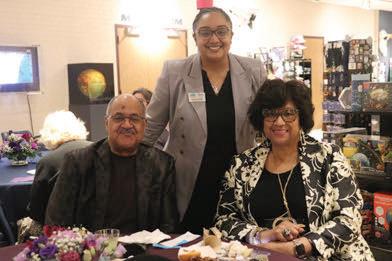

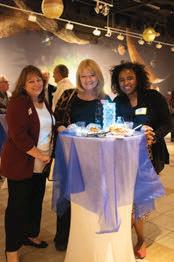
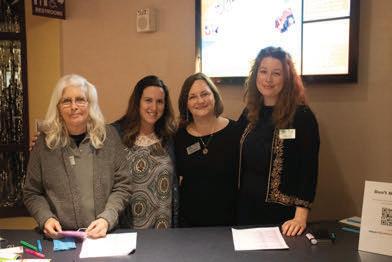


“The Motown Story”
The New McCree Theatre
5.4-20.2023
“The Spongebob Musical”
Flint Community Players
5.11-21.2023
Michael W. Smith
The Capitol Theatre
5.12.2023
Jazz at MacArthur
MacArthur Recital Hall
5.12.2023
“Two by Two”
Clio Cast & Crew
5.12-21.2023
Kidz Theatre Kompany Presents: “Mirror Image”
Fenton Village Playhouse Theatre
5.12-21.2023
Hurley Benefit Ball
Gateway Hotel & Convention Center
5.13.2023
Festival of Dance
UM-Flint Theatre
5.13.2023
A Piano Quintet
MacArthur Recital Hall
5.19.2023
Frame 42
The Machine Shop
5.19.2023
8th Annual DHS Car Show
Davison High School
5.19.2023
Tux & Tennies
Gala and Auction
Randy Wise Motorcars
5.20.2023
FSO Presents: Rachmaninoff & Beethoven
The Whiting 5.20.2023
Flint City AFC vs. Detroit City FC Atwood Stadium
5.20.2023
Flint United vs. Lebanon Leprechauns
Ballenger Fieldhouse
5.21.2023
Flint City AFC vs. AFC Ann Arbor Atwood Stadium
5.26.2023
Flint City Bucks vs. Midwest United Atwood Stadium 5.27.2023
Flint United vs. Jamestown Jackals
Ballenger Fieldhouse 5.28.2023
The Accidentals
The Capitol Theatre 6.2.2023
“Magic of Play” Summer Party
Flint Children’s Museum 6.16.2023





BY LESLIE TOLDO
When I open my personal email inbox, I am usually overwhelmed with invitations to shop from the many retailers whose offerings I browse online. The solicitations are filtered into one folder. I have been known to simply open that folder and hit “delete all” but in recent weeks, something has stopped me. I keep getting similar emails sent by everyone from small boutique owners to big-box store marketing departments, letting me know I can opt out of their Mother’s Day promotions. So far, I have deleted them all; but the sentiment gives me pause.
This will be my fifth Mother’s Day without my mom. She died suddenly in June 2018. She lived in Baton Rouge, LA so we had spent that last Mother’s Day as we typically did – apart. Had
I known I would never get another chance to spend the day with her, I probably would have flown home to see mom, and made it a big celebration. Instead, I figured, “Maybe next year.”
The first Mother’s Day after mom died was an agony I would not wish on my worst enemy. First of all, it is not just one day; it is an entire shopping season. For that reason, I am grateful for the new “opt out” trend retailers are jumping on. I only wish that missing a few of those emails would take the pain away. If I thought that would work, I would have opted into opting out.
Surprisingly, what helps me most on Mother’s Day, and really on any day I find myself steeping in the heartache of losing her, is seeing other people appreciate the mothers they still have.
I would love to say that I appreciated every moment I had with mom, but that would not be true. There were times when I did not want to answer the phone because I was sure I was going to get an “obituary update.” Funny – I would give my front teeth to go through the whole, “Didn’t you know…?” whomever happened to land in the obituaries that day.
Moms can drive us crazy, but there is no one on Earth who loves us quite like they do. J.K Rowling said, “Love as powerful as your mother’s for you leaves its own mark. To have been loved so deeply, even though the person who loved us is gone, will give us some protection forever.”
Those words are a comfort, but I would still rather that protection was only a few states away on any given day, there to answer my calls. No matter how annoying or crazy I ever was, my mom always answered the phone. No matter what I said or did, she always loved me, and in a way no one else ever has or could.
That’s why, as one internet quote I found explains it, being without that love is so incredibly hard. “My heart still aches in sadness and secret tears still flow; what it meant to lose you, no one will ever know.”
If your mother is still living, treasure her. See her. Talk to her. Answer her calls. Love her. Do it every day – not just on the second Sunday in May.

An Emmy-nominated anchor/meteorologist/ reporter at FOX66 and NBC25, Leslie Toldo recently retired from TV news after a career of over 30 years, nearly 20 in Flint. She is a blogger, writer, wedding and funeral officiant. Born and raised in Baton Rouge, LA, she graduated from the University of Wyoming. An avid kayaker, boater and runner, Leslie lives in Linden with her husband, Ellie the cat and two dogs: Gus and Lucy.


BY VERA HOGAN
There is a line in the “Top Gun” movies that applies not only to fighter pilots, but anyone with a heartbeat – and that is: "I feel the need … the need for speed!"
Over the years, our house was filled with Hot Wheels and Matchbox cars, toy trains, trucks and airplanes. As the kids grew older, their need for speed moved on to skateboards, snowboards and amusement park rides, not to mention speedy deliveries, fast food, and high-speed internet. And the entire family loves fast cars.
In addition to the Kentucky Derby, which on the first Saturday in May showcases the world’s fastest race horses, the month of May is famous for the Indianapolis 500 – a huge, monthlong celebration in anticipation of the main event that will take place this year (the 107th running) on Sunday, May 28 (televised on NBC starting at 11 am).
Michigan can boast one Indy 500 race car driver – Gordon Johncock of Hastings took the checkered flag in 1973, and again in 1982. Quite an achievement.
The first Indy 500 took place in 1911 at the Indianapolis Motor Speedway
(built in 1909). Thirty-three cars take part in the annual event, which has been dubbed the “Greatest Spectacle in Racing.” The first race attracted top drivers and cars from around the world, and drew a crowd of 80,000 people. Today, the Speedway has a permanent seating capacity for more than 257,000 people and infield seating that raises capacity to an approximate 400,000.
As part of the festivities, the City of Indianapolis hosts “The Greatest Spectacle in Running.” Participants make their way on foot through downtown Indy, take a lap around the Indianapolis Motor Speedway and finish their journey at 13.1 miles. On Saturday, May 6 more than 20,000 participants will take over the streets of the downtown for this OneAmerica 500 Festival Mini-Marathon.
The annual AES 500 Festival Parade is one of the nation’s largest parades,

ranking right up there with the Pasadena Tournament of Roses Parade and the Macy’s Thanksgiving Day Parade. More than 200,000 people will line the streets of downtown Indy the day before the race to enjoy the larger-than-life floats, giant helium balloons, award-winning bands and all 33 drivers who will be competing in the Indy 500.
It is a tradition for the winner to drink a pint of milk at the end of the Indy 500. This was started in 1936 by winner Louis Meyer who guzzled a post-race bottle of chilled buttermilk. Although Indianapolis is only a few short hours away by car, getting race tickets at this point could be a challenge. But the best seat in the house to catch all the action could be on TV –right in your own living room.
Have fun and don’t forget the milk. Cheers!
Recently retired, Vera Hogan is a 20-year veteran of the newspaper business, having served both Fenton and Flint area publications. During those years, she was a reporter, associate editor, editor, web content editor and columnist. Her popular columns have earned her multiple state awards. She resides in the City of Fenton. Email verahogan@hotmail.com.

BY MARC JANCA, AIF®
While we all hope for the best, it's important to be prepared for the worst. Unexpected events such as job loss, a medical emergency or car repairs can throw our finances off balance, leaving us scrambling for ways to cover the expenses. This is when an emergency fund comes in handy. In this article, we'll discuss the importance of having an emergency fund and how to build one.
An emergency fund acts as a safety net, a stash of cash set aside to cover unforeseen expenses and help reduce financial stress. Emergency funds should be easily accessible and liquid, meaning you can withdraw the funds quickly without penalties or fees. Most people rely on a bank savings account or if they are looking for some higher interest, will consider a money market fund. Emergencies can happen to anyone at any time and without an emergency fund, you may have to rely on credit cards or loans, which could result in more debt and higher interest payments. According to the 2022 Bankrate® savings report, 36% of Americans have more credit card debt than emergency savings, which is the highest on record since 2011.* An emergency fund can help you avoid this, allowing you to cover expenses without going into debt. Knowing you have a safety net in place can also give you confidence.
The amount you need in your emergency fund depends on your individual circumstances. As a general rule, financial experts recommend having three to six months' worth of living expenses. This means that if your expenses are $3,000 per month, you should have between $9,000 and $18,000 in your emergency fund. However, if you have dependents or a high-risk job, you may need to save more. Unfortunately, only 43% of all U.S. adults would pay for an emergency expense from their savings, according to Bankrate.com.**

Building an emergency fund requires discipline and consistency. Here are some steps to follow:
➊ Set a savings goal. Decide how much you want to save and set a realistic timeline. Start by saving a small amount each month and gradually increase the amount as you become more comfortable.
➋ Cut expenses. L ook for ways to free up some cash to save. This could mean cutting back on eating out, canceling subscriptions you don't use, or reducing your energy bills.
➌ Automate your savings. Set up automatic transfers from your checking account to your emergency fund. This will make it easier to save consistently and remove the temptation to spend the money elsewhere.
➍ Use windfalls. Whenever you receive unexpected income, such as a tax refund or a bonus, put it into your emergency fund.
➎ Keep it separate. Keep your emergency fund in an account separate from your checking account to avoid the temptation to dip into it for non-emergencies.
In conclusion, an emergency fund is important for financial stability and confidence. Remember, the key is discipline and consistency – start small, stay consistent and watch your emergency fund grow over time. By following these simple steps, you can be prepared for whatever the future holds.
*bankrate.com/banking/savings/emergencysavings-report/ **bankrate.com/banking/savings/emergencysavings-report/
Marc has a bachelor’s degree in finance from the University of Windsor. He got his start in the financial industry in 2005 and started his career at the Royal Bank of Canada as an investment advisor. Upon moving to the U.S., he spent ten years at Chase Bank, where he learned a lot about what the industry has to offer. Today, he is a financial advisor who can offer investment and insurance products and services with confidence. Marc and his wife, Ana, have two young daughters -- Sasha and Dylan.

BY DR. CHRISTOPHER DOUGLAS
Due to losses on its bond portfolio, Silicon Valley Bank collapsed in March. What happened? Bonds are safer than stocks, but not perfectly safe. Bonds carry two risks: default risk and interest rate risk.
A bond is a loan; the bond buyer is giving a loan to the bond seller that is repaid with interest. Default risk means the borrower might stop making these payments. This is what occurred during the 2008-09 financial crisis when the housing market crashed, homebuyers stopped making mortgage payments, and thus those who bought mortgage-backed securities never recovered their money. Ratings agencies estimate a bond’s default risk, though these ratings were flawed during the financial crisis. Interest rate risk is perhaps less well-known. Suppose someone buys a $1,000 ten-year bond that pays a fixed 2% interest rate over the life of the bond. If the buyer holds the bond until maturity, they get their $1,000 back at year ten and the 2% interest earned every year before then. If the buyer wanted their money back early, they could sell the bond in the bond market. Assuming the interest rate on ten-year bonds remained at 2%,
they could sell the bond for $1,000 as the new buyer would be indifferent between buying this bond or a newly issued bond as both are paying the same interest rate.
The original bond buyer is in trouble if interest rates rise. Suppose the interest rate rises to 4%. Now, the buyer is trying to sell a bond paying 2% interest while newly issued bonds are paying 4% interest. The only way he can now sell is if he offers a discount on the price. In this example, he would have to cut the price on his bond to $866 so that the new buyer is indifferent between buying this bond paying 2% interest and a new $1,000 bond paying 4% interest. The original buyer thus takes a $134 loss.
This explains what happened to Silicon Valley Bank. The bank used customer deposits to purchase bonds – in particular, mortgage-backed securities – during the pandemic when interest rates were low. When mortgage rates rose following Federal Reserve tightening, the value of these mortgage-backed securities plummeted. There are hedging strategies banks use to guard against interest rate risk. The Silicon Valley Bank did not employ them as they aren’t required for bonds the bank is planning to hold to maturity.
If the value of a bank’s assets falls, the bank becomes less able to repay depositors. Silicon Valley Bank’s depositors noticed and since many of them are active on Twitter, quickly raised the alarm that the bank was in trouble. Depositors raced to the bank to withdraw their funds and given the loss on its bonds, the bank was unable to sell them to raise the cash needed to meet this withdrawal demand. It remains to be seen how many more Silicon Valley Banks are out there if the Federal Reserve continues raising interest rates.

Dr. Christopher Douglas came to the University of Michigan-Flint in 2006. He earned a B.S. in Electrical Engineering and a B.S. in Economics from Michigan Technological University in 2001, and his Ph.D. in Economics from Michigan State University in 2007. As Professor of Economics and Chair of the Department of Social Science and Humanities, he teaches Principles of Microeconomics, Principles of Macroeconomics, International Economics, Public Finance, and Sports Economics.

BY ALEXANDRIA PAZIENZA-NOLAN
Currently, my partner and I are in the crucial phase of planning our big, summer adventure. Why crucial? One reason is because I have a “Type A” personality, so planning is required, and secondly, because two adults on their first European vacation as a couple plus one small boy equals, again, some advance planning.
Initially, the plan was an Italian tour – starting in Naples, extending along the Amalfi Coast and then heading toward the Puglia region. Hotel was booked! Friends and family were informed! But, then, there were no feasible flights to take. Not into Rome or Naples nor any other halfway convenient Italian airport. Lots of flights to get there, no flights without a layover of at least 12 hours to get home. So, back to the drawing board.
We attempted to book into Paris, Bergen, London. We tried multiple South American countries, all would not work for one reason or another.
But then, a miracle. A moderatelypriced flight with a perfectly appropriate layover was available to ... Barcelona.
This was not a problem insomuch as it was, well, the same destination my son Arthur and I journeyed to last year. And, his godmother lives there, it's a familiar place that we love and now, with another adult to take over some of the vacation's headaches, perhaps now we could go further afield, perhaps to Andorra or Southern France, as well. And so the planning began.
Restaurant suggestions exchanged via text, menus poured over. Links to open-air markets, wineries, ideas for day trips, rates for the train, rental car. We found medieval villages that weren't too long a drive, and looked up how easy a trip on the metro would be to this place or that.
Unlike Arthur and me, my partner has never ventured out of the U.S. –never been on a trans-Atlantic flight or ran through an airport at top speed to make a connection. So, it goes without saying that this trip feels important, at least to my family, as it promises, for good or ill, to be a life-changing experience. An important first for him and for our relationship. It's also a big step for my son, as every year he grows a little older as we travel. A little more aware of the culture, the language, more comfortable with strange food, more open-minded and capable, a four-year-old boy of the world.
But trips like this take a lot of thought, planning and care. This is the boring part, even if it sets up the

excitement and anticipation of the adventure ahead. This is the time to consider questions like, "How will we get from the airport to the hotel – the train that costs €3 or the uber that costs €40?” (The obvious answer is uber after the 12 or so hours in the air).
“What days do we drive to Tossa de Mar to go to the beach?” “When do we day-trip to the medieval town of Baga or to Andorra to escape the city a bit?” “When's the best time to book train tickets?” All these questions are answered in advance in order to save a little headache when we're there.
My hope is that all the planning will lead to more nights sipping cava under the stars or heading from one tapas bar to the next, worry-free. A look at some menus beforehand might tell me which restaurants serve cheeseburgers for small boys with expanding but honestly, pretty limited tastes. I hope that if I put a little extra time in now, I can take a little extra time off then.
May it be the first well-planned trip of many for the three of us, and hopefully leave us already plotting the next.

Alexandria Nolan is a misplaced Michigander currently living in the wilds of the Houston urban jungle with the world’s most charming pre-schooler. She is a published novelist and contributor to various online and print publications, including a lifestyle blog, AlexandriaNolan.com. When not writing, she can be found teaching, reading or traveling, or reading about traveling.

BY CHERYL DENNISON
On Mother's Day, moms everywhere are celebrated – it’s a joyous occasion filled with flowers, gifts and delicious meals (that mom didn't have to cook). I have many fond memories of the day spent with my own kids, relaxing, enjoying handmade cards, bouquets of flowers (sometimes wilted) and breakfasts in bed (sometimes burned) prepared by little hands.
My oldest son would always plant a rose bush for me on Mother's Day. Sometimes we would go to a movie, to a restaurant or just stay at home and plant flowers or cook dinner on the grill. Relaxation is probably one of the most appreciated gifts for moms on their special day. Sometimes, the celebration is less enjoyable. Last year on Mother's Day, my daughter Melissa and I accompanied her son (my grandson) Mack to a hotel in Detroit where we spent the night before he left early the next morning for Parris Island, SC. He had just graduated from
high school, turned 18 years old and joined the U.S. Marine Corp., heading off to make his own way in the world. It was the worst Mother's Day we had ever experienced. My daughter was terrified for him and many tears were shed. Not only did Melissa have to give up her son to the Marines, she had to do it on Mother's Day! Mack survived boot camp and is now well into his training to become a helicopter crew chief at Camp Pendleton in California. This year, Melissa is arranging a trip to visit him there.
It's sometimes hard for a mother to let go. I remember when my oldest grandson left to attend college at Michigan Technological University. It was very hard for my daughter to not have him home on Mother's Day. This year, his third year at MIT, he will be going to San Antonio, TX to begin an internship. Again this year, he will not
be home for Mother's Day. But he is well on his way to a successful career.
My own son missed many Mother's Day celebrations while attending Michigan Tech. He is now very happy and is a successful engineer in Washington State. I always receive a phone call from him wishing me a Happy Mother's Day. Melissa, who lives nearby, always celebrates the day with her mom and tells me how much she appreciates what I have done for her.
Luckily, two of my grandsons still live at home, well on their way to following the happy and successful footsteps of their big brothers under the guidance of a mom who has taught them well. They will celebrate Mother's Day with Melissa to honor and appreciate all she has done for them.
What is the greatest gift a mother can receive on Mother's Day? To me, the greatest gift is watching her children grow up to become happy and successful, knowing that they appreciate everything you did to help them get there. You really can't ask for much more than that.
Mother's Day!















“If any one steal cattle or sheep, or an ass, or a pig or a goat, if it belong to a god or to the court, the thief shall pay thirtyfold therefor; if they belonged to a freed man of the king he shall pay tenfold; if the thief has nothing with which to pay he shall be put to death.”
– Law 8, Code of Hammurabi.
Written between 1755-1750 BC in Babylon, the Code of Hammurabi is one of the earliest and most famous examples of early law. The definition of law is fluid but may be defined as a set of rules that are created and enforceable by social or governmental institutions to regulate behavior. The development of law mirrors the development of civilization itself. Ancient Egyptian law dates back to 3000 BC and its pronouncements are based upon the concepts of truth, harmony, order, morality and justice. The first known law “code” was started
BY PETER HINTERMAN
in approximately 2200 BC by Sumerian King Ur-Nammu. It consisted of simple “if … then …” statements, usually doling out harsh consequences for those who deigned to “break” the law. When Hammurabi came to power around 1760 BC, he built upon the statements made by Ur-Nammu by adding to, codifying and inscribing them in stone. The 282 “laws” are now known as the famous Code of Hammurabi.
The Code was copied, written in Akkadian, and inscribed throughout the Kingdom of Hammurabi with the most complete example inscribed upon a basalt stele being held in the Louvre Museum in France. It begins with a prologue establishing Hammurabi’s authority over all matters of law and the reasons for the creation of the law which includes “to destroy the wicked and evil doers” and “so that the strong should not harm the weak.” What follows are 282 statements of infractions and their penalties, usually extremely harsh,

from different aspects of society such as property, land/homes, commerce, marriage/family, assault, agriculture, and others. Examples include “If any one store corn in another man’s house he shall pay him storage at the rate of one gur for every five ka” and “If a man take a wife, and she be seized by disease, if he takes a second wife, he shall continue to support his first wife for as long as she lives.” The Code ends with an epilogue that again establishes Hammurabi’s backing of the gods and his ultimate authority. When it came to foreign policy, King Hammurabi was a brutal and unmerciful tyrant; but at home he considered himself the “people’s shepherd” and worked to maintain order and harmony using the law as he had established it.
The Code of Hammurabi provides details as to what it took to maintain an ordered society in a chaotic and brutal world. Today’s law looks to do the same.

